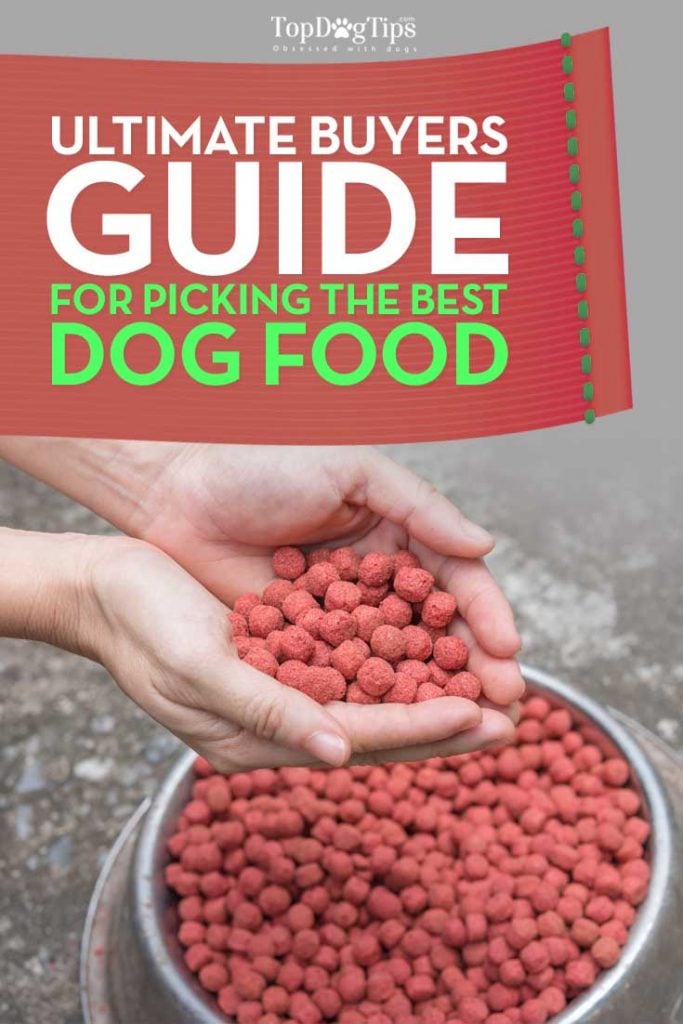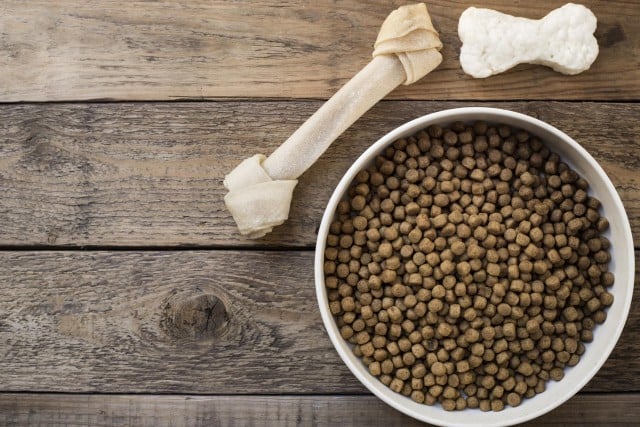
Table of Contents
- Table of Contents
- Chapter One General Dog Food Information
- Chapter Two Dog Food Issues and Problems
- Chapter Three Choosing the Best Dog Food for your Dog
- Chapter Four How do know what’s best for different dogs?
- Chapter Five Dog Food and Doggy Nutrition
- Chapter Six Dog Food FAQs
There are tons of options out there for the best food for dogs available today, and it can be very intimidating for new pet parents and those new to the dog world knowing how to choose the best dog food brand.
The plethora of choices makes for a confusing trip down the supermarket aisle, and many of us have been in that position before.
Fortunately, with the proper know-how and education on what are the criteria in choosing the best food for dogs, you’ll be able to select your pet's favorite dog food brand that is not only healthy for your specific dog but also the type of kibble your dog will not refuse.
Part of selecting the right dog food is knowing what exactly you're looking for. You also need to have some basic understanding of the components and ingredients that make up dog food that are vital for your pet’s diet and the ones that have the potential to be harmful to your dog.
My dog, an Australian Shepherd named Walter, is notoriously picky. When we adopted him from the rescue shelter as a puppy, he put us through the wringer when it came time to select his dog food brand.
It seemed as though the foods he liked were all unhealthy for him, and the foods he despised were the best for his health.
It took a process of (costly) trial and error for us to finally find the best dog food brand that Walter was acclimated to and that would keep him growing as a healthy canine.
When it comes to finding the best food for dogs, all dogs will always demonstrate their say in the matter.
My Walter had his share of picky habits. Still, much of the process’s difficulty was due to us not really knowing how to select the best dog food for him and what to look for in terms of dog food ingredients, quality, and other important dietary indicators.
Now, as a long-time dog owner, I know that reading and learning about food for dogs is vital.
Back then, some type of dog food buyer’s guide would have helped my family and me immensely in our search, and it’s in that vein of education and understanding that this free best dog food buying guide is made.
All pet owners want to know how to make their pets grow healthy, active, happy, and strong without accidentally harming their health due to improper dog nutrition.
As pet parents, we also want mealtime to be fun for our dogs, not a drudge-fest that makes our pets openly resent us.
In this dog food buyer’s guide, we’ll show you all of the features and aspects of the best dog food brands that you need to know as a pet owner to get you on the right track to purchasing the most appropriate nutrition for your pooch.
Below, I'll give you a brief index of the topics that we will cover in this dog food guide. This way, you’ll know just what to look for and what you’ll be reading.
I hope that this buyer's guide will be fun, practical, and, most importantly, informative enough for you to become acquainted with the terminology and ingredients in dog food and the health benefits and risks associated with such ingredients.
Table of Contents
1. General Dog Food Information
1.1 What is dog food?
1.2 How and where is dog food made?
1.3 Different types of dog foods
1.4 Hypoallergenic dog food
1.5 Dog food nutrition guidelines
1.6 Dog food terminology explained
2. Dog Food Issues & Problems
2.1 Dog food recalls and what to do about them
2.2 Additives in dog foods
2.3 Dog food safety
3. Choosing the Best Dog Food for your Dog
3.1 Picking dog food wisely—things to consider
3.2 The most important ingredients on the list
3.3 How to pick dog food based on the dog's breed and size
4. How to Know What’s Best for Different Dogs?
4.1 Puppies, adult dogs, and seniors
4.2 Dog allergies
4.3 Overweight dogs
4.4 Low-fat dog food
4.5 Low-protein dog food
4.6 Grain-free dog food
5. Dog Food and Canine Nutrition
5.1 Dog diets and how to implement them
5.2 Dog treats and dog chews
5.3 Homemade dog food
6. Quick Best Dog Food FAQ Session
6.1 What ingredients must be in dog food?
6.2 What ingredients should NOT be in dog food?
6.3 Should I avoid meat by-products?
6.4 Should I avoid grains in dog food?
6.5 What to do after dog food has been recalled?
Chapter One
General Dog Food Information
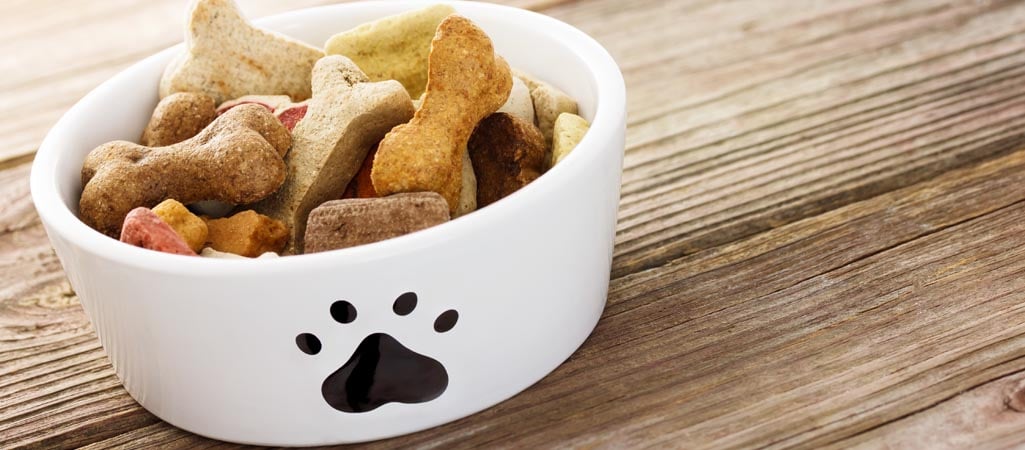
1.1 What is Dog Food and Why You Need this Guide?
This question may seem like a total no-brainer. I suppose that a more fitting question would be, “Why can’t I feed my dog people food from the table?”
Table food (human food) is fine for humans, but a lot of it can be very toxic to dogs. Although humans are no strangers to sneaking their pups an extra something under the table here and there, making a habit out of this practice—or giving your dogs human food in large quantities—is actually a very inadvisable thing to do.
Dogs can’t eat certain human food because their bodies are not set up to digest things the way a human's body does.
There is a way to cook food for your dog, but that requires special knowledge from your pup's nutritionist and strict limitations on what you can feed them and how to prepare the food. But that's for a whole different conversation.
Right now, we are talking about your table scraps that you prepared with sauce, other foods that your dog cannot process, or to-go food you picked up and feeding them what you don't finish.
Human foods are often saturated in fats, preservatives, additives, and other unnatural things that dogs don’t process the way we do simply because their bodies don't evolve.
Dogs who eat a lot of table food tend to gain weight and become recalcitrant, as the food inhibits their exercising capabilities and other physical activities.
On the other hand, dog food is specifically formulated to fit your dog’s dietary needs and requirements.
Dogs tend to eat more meat and fewer grains than humans.
Meat provides animal proteins vital for dogs’ growth and bone structure, and humans don’t require that same high level of sustenance.
Even though eating “clean” foods is certainly a good idea for us, a human's body doesn't require such a high amount of protein and a low amount of carbs as a canine's body.
Dog obesity, while certainly not on the same national awareness level as human obesity in America, is still problematic.
Veterinarians are concerned about the high level of obesity in dogs.
As of 2022, the Association for Pet Obesity Prevention has estimated that a whopping 59% of dogs are obese or overweight.
Human foods, lack of dietary discipline, and minimal exercise have a lot to do with those statistics and their disturbing results.
Obesity-caused illnesses in dogs, just like humans, reduce the quality of life for your pet and can lead them to have a shortened life span that takes them away from you.
Canine obesity-caused illnesses in dogs resemble those of humans. They involve a high cholesterol level, blood pressure problems, damaged bones and joints, fatigue, and mental and physical detriments that prevent your pet from living their life to the fullest.
Obviously, we don’t want to lose our pets due to improper nutritional choices, much less to a preventable condition, so reducing and nixing the table food is a very good goal for owners.
The most common conditions caused by obesity in dogs are:
- Arthritis
- Bladder/Urinary Tract Disease
- Low Thyroid Hormone Production
- Liver Disease
- Torn Knee Ligaments
- Diabetes
- Diseased Disc in the Spine
- Fatty Growth
- Chronic Kidney Disease
- Heart Failure
The statistics on obesity in pets are scary.
Fortunately, those numbers can be decreased, and we can restore the health of our pets through one smart decision at a time.
It starts with proper dog nutrition and choosing the best food for dogs that's healthy for them.
It is very tempting for all of us to give dogs human food from the table, especially when dogs look at you with those puppy eyes that simply implore you to give them a treat.
It’s understandable.
But you need to make sure that you are sticking to proper dog food only when it comes to feeding your canine and completely exclude human food from your Fido's diet.
Even though you may think that a little piece of hot dog here or there, or a hamburger chunk occasionally, isn’t going to hurt them, there's absolutely no reason to train your dog that he or she should expect any treats from the table. As owners, we cannot allow that to become a regular practice because there's an increase in quantity and a decrease in dog's health before we know it.
Commercial dog food diets are formulated to keep your pup in tip-top shape, especially if you purchase organic, holistic, and human-grade healthy dog food that keeps in mind the natural condition of dogs as meat-biased omnivores.
Dogs, ancestrally, have always eaten meat. Meat is an important part of their diet, and animal proteins promote lean muscle growth and strong joints, bones, and ligaments.
A human’s diet isn’t based on that ancestral urge for meat—we are omnivores, and we don’t have the same needs and requirements as dogs.
Even though many label dogs as omnivores, a canine's nutritional base is still animal meat proteins.
Dog food companies understand that and are dedicated to providing their customers with high-quality dog nutrition that will boost their pet's quality of life to the fullest.
Some pet owners might feel that that is negotiable, especially since dog foods are often recalled, and there is a concern that no additional measures are being taken to prevent further dog food recalls or side effects of these diets.
We all want to be certain that our dogs' food is natural and is not manufactured in some unknown factory in China.
It's true – there are some bad quality commercial dog foods out there, but most of the famous dog food brands out there are actually pretty good and healthy for dogs.
Alternatively, you can always opt to make your own homemade dog food, which is a totally viable option, and we will cover that aspect here, too.
This best food for dogs guide will demonstrate selecting the most reputable and trustworthy dog foods. In one of the next sections, we explain how to handle a dog food recall and what to do about it.
This dog food guide is a comprehensive and exhaustive analysis of the best ingredients in dog food, and we hope that you’ll rest assured that the quality of dog food companies is, in most cases, the highest out there.
Dog food doesn’t have to consist solely of human-grade ingredients for it to be reputable. In the next chapter, we’ll discuss how dog food is made, going all the way back to where it is grown.
Knowing the origins of your pet's food is important for anyone a little squeamish about buying bagged kibble in stores.
Continue to the next section to learn more about the process of cultivating the ingredients for dog food.
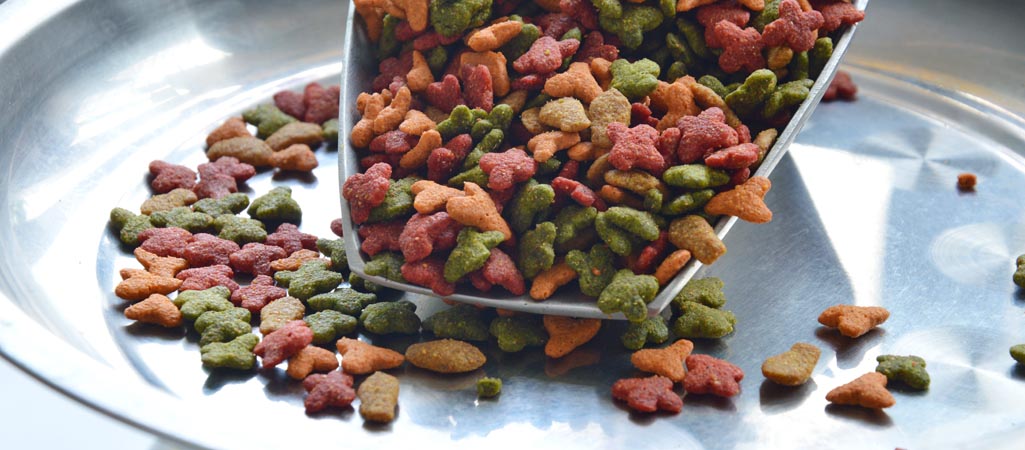
1.2 How and Where is Dog Food Made?
Dog food made in America is cultivated here in most cases, although some companies outsource their ingredients (some or all of them) to China because it is much cheaper.
Those companies that outsource to China are to be avoided because, as we’ll discuss a little later, China has a problem with quality control and consumer safety that extends not only from human products but also to dog food.
How dog food is made depends on whether or not it is dry food or wet food.
Regardless, the ingredients start on the farm (for this section, we’ll just assume that the dog foods we are talking about are made naturally and are organic—that’s the best dog food to select anyway).
Dog foods that contain animal proteins such as chicken, turkey, beef, bison, or any other meat get their start on the farm.
Ethically raised farm animals (the term “ethical” when used to describe dog food generally describes cruelty-free farming and slaughtering) are not kept in tiny, close-together cages that are dangerous and disease-filled.
A Certified Humane product is free-range or pasture-raised. Chickens, for example, that are raised in free-range systems have to have a space that is not sodden, damaged, or dirty.
They have to have a vegetative cover that sustains their food and diet habits, and there have to be adequate exits (at least four) in their building so that they aren’t all trapped in there together.
Pigs and cows, another common animal whose meat is used in dog food, have to have enough space in their stalls for them to exist comfortably.
They have to be able to go outside and waddle around to their heart’s content without being cruelly treated.
They have to be able to turn around in their stalls comfortably and stretch out without feeling cramped.
Ethical farming is the responsible way to produce dog food.
It is also sustainable, as one of the other conditions of ethical farm practices requires farmers to be environmentally conscious and only engage in methods that don’t strip the land or make it impossible to reuse.
Treating the land well prevents toxins from seeping into the dirt and making large swaths of land barren.
Fish, especially salmon, are used in dog food because they provide an excellent source of Omega fatty acids. Fishing ethics dictates that the fishermen don’t over-fish and drain the aquatic environment of the resources needed for a balanced ecosystem.
These ethical practices are relevant to this dog food guide because, according to the Humane Farm Animal Care Organization, 68% of consumers want to know where their products are being made and how.
With recent expositions on the cruel practices that go on at certain farms, people are beginning to take notice, and we as pet owners should as well because farm animals, though they’re not high on the food chain, should still be treated as ethically as we do our pets.
Many of the ingredients in dog food are found on farms located all across America, with especially heavy concentrations in the Midwest.
While it’s a relief to know that much of our dog food is made here in America, it’s less of a relief to consider that not all dog food ingredients are sourced ethically.
Once the ingredients come off the farm, whether wet or dry, dog food is subject to the standards demanded by the Association of American Feed Control Officials (AAFCO), which require that pet food be nutritionally balanced and that it provide a complete diet.
Were these marketing requirements not in place, people could advertise their products as anything they wanted. The AAFCO prevents that from occurring.
After being approved, the ingredients are ground together to make a consistency that can be made into dough.
For those who didn't know, this may be an interesting fact: dry dog food has been commercially produced since the 1800s, and the method has stayed essentially the same.
The dough is baked and forced through an extruder while under high pressure.
That kibble dough is extruded through specially shaped holes and then cut off by a knife, all while still in a doughy, half-baked consistency.
Dog food dough is then put through a dryer to have the rest of the moisture sucked out of it.
The dried dough is sprayed with vitamins, minerals, and other fatty oils and nutrients to provide nutritional value.
The dough of dry dog food (kibble) is a carrier for the nutrients and allows for the type of shape we want to see the most.
Wet dog food follows a different process and usually contains gravy to keep it from getting dried out.
The ingredients are combined in a mixer, and then they are sealed to preserve freshness and wetness.
Then, the sealed-off ingredients are cooked to lengthen their shelf life.
Wet dog foods (canned dog food) are normally cooked in cans, cooled, and then sold as-is (with an extra label or two to mark them).
Cooking wet dog food in cans doesn’t lose its nutrients or flavoring. Whole-Dog-Journal.com actually had a great article on how wet dog foods are made if you're interested in the process.
Understanding how dog food is made, including the ethics of farming and sourcing, is vital for selecting the best food for dogs.
That process, though we’ve laid it bare-bones here, is adjusted and improved upon by companies.
Their adjustments to the basic dog food manufacturing process have positive, negative, or both implications for their general quality level.
What a company does during the food is an important but often overlooked part of selecting healthy dog foods.
The shelf-life of the pet food and its stability and resistance to spoilage are determinants of how the company upholds the manufacturing and processing of its product.
The next section will discuss the types of dog foods that companies produce, including their benefits, advantages, disadvantages, and characteristics.
These types of dog foods are well-known and are words that you will frequently hear throughout the course of selecting the best dog food.
To pick the most optimal product for your Fido, you need to have a thorough understanding of the meanings of each and what they can (and cannot) do for your pet.
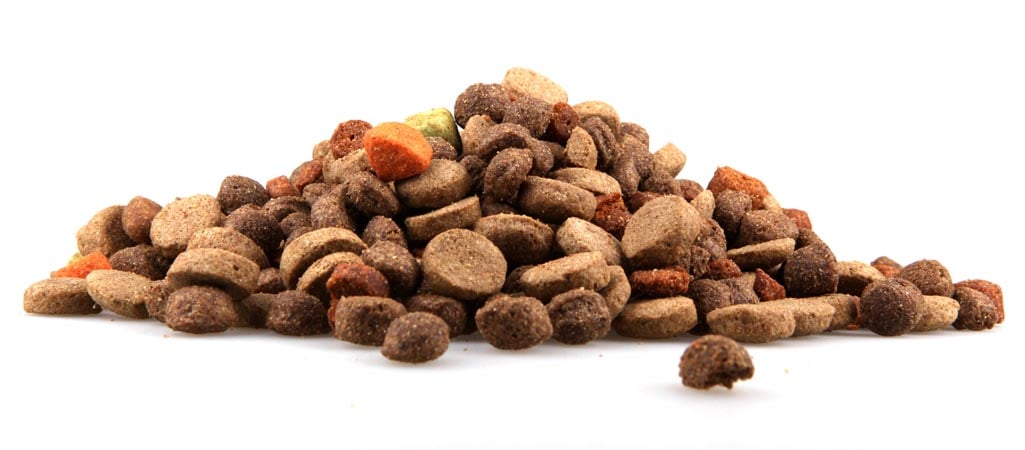
1.3 Types of Dog Foods
All dog food companies understand that their doggy clientele is vast and not all dogs have the same tastes. Much like human foods, dog food varies based on consistency, type, and general attributes.
In this section, we’ll discuss the seven major types of dog food: wet food, dry food, raw food, grain-free food, vegan, puppy-specific dog food, and food that is considered “LID” or “Limited Ingredients Diets.”
Wet dog food
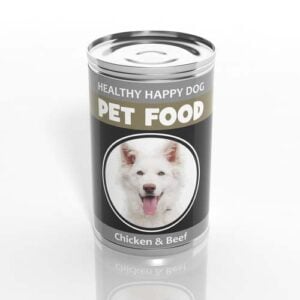 Canned dog food, also known to many as wet dog food, includes pet foods sealed in cans, pouches, or other containers that preserve the moisture within them.
Canned dog food, also known to many as wet dog food, includes pet foods sealed in cans, pouches, or other containers that preserve the moisture within them.
Wet dog food has a saturated consistency and, while not completely liquid, does contain a lot of moisture (hence the name).
This type of dog food is usually canned because, as we stated before, this dog food is cooked whole in the can, and the cans are cooled down after that process is completed.
Wet dog foods can serve as a source of hydration for your dog since they contain water.
Canned dog food and wet dog food are interchangeable terms, as you’re unlikely to find canned dog food that isn’t wet.
Wet dog food is often a good choice for older dogs because it is more flavorful and tasteful than other dog foods. That is because of its sealed properties.
Wet dog food still contains the same meats and protein content as dry dog food, but canned dog food often has it in larger quantities while also containing fewer carbohydrates.
Meat is normally the primary ingredient in canned dog foods, and this type comes in flavors like “turkey and gravy” or “chicken and gravy.”
Dogs love gravy! Those canines that are picky eaters or faltering olfactory prefer wet food because the smell is stronger and the flavor is more intense.
Canned dog foods are distributed by weight and are generally bought in smaller amounts. Wet dog food also tends to be more expensive and has a more rapid expiration date once opened.
It loses its shelf life once it is opened, and if you decide to open it and your dog doesn’t want to eat it, it needs to be refrigerated and covered immediately.
It's a simple fact that canned dog food is more expensive for the owner.
Still, it is a good nutritional choice for puppies, as it retains more of its vitamins and minerals during the processing stage than kibble does (though a balance of wet and dry food is recommended by veterinarians).
Dry dog food
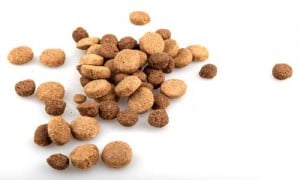 Kibble, also known as dry dog food, comes in bags and is distributed higher than wet dog food.
Kibble, also known as dry dog food, comes in bags and is distributed higher than wet dog food.
The process we discussed in the first section makes dry dog food: it is made using dough that is kept under high pressure and extruded through multi-shaped holes for sizing.
The dough that is used to make kibble is dried out and sprayed with a solution containing the nutrients and fatty acids the company wants it to have.
Dry dog food is not as rich in aroma or flavor as wet dog food, but pets still find it delicious.
This dry dog food has little water to it, and you should always make sure that you have a bowl of water out for your pet if you are feeding him or her kibble.
Dry dog food and wet dog food combined make a healthy diet. Many pet owners prefer dry dog food because it is convenient.
For example, you can leave a bowl out for your Fido while you are gone during the day, and you won’t have to worry about it spoiling because the shelf life is much longer than wet dog food's expiration dates once it is opened.
There is a constant back and forth about what is better, wet or dry dog food.
In reality, just like with any food, it is all circumstantial and depends on what you consider “best.” Dry dog food has been around for a very long.
A quick history lesson: dry kibble actually came from a crumbled-up biscuit that an electrical engineer from Ohio named James Spratt dropped on the ground and then looked at and decided would make a great type of dog food.
The story goes that James baked crumbled-up biscuits and added some flavoring, and that was how dry dog food was born.
Kibble is beneficial for dogs’ teeth and gum health because it is so chewable.
Kibble, if a large enough size, helps scrape tartar and plaque formations off of your dog’s teeth, preventing buildup. Kibble has dental benefits that make it an excellent accompaniment to wet food.
Raw diet dog food
 Raw dog food operates from the principle that dogs are meant to eat in their natural state, the way they did ancestrally back in the caveman days.
Raw dog food operates from the principle that dogs are meant to eat in their natural state, the way they did ancestrally back in the caveman days.
This “primal pet food” consists of the same foods that, theoretically, your dog would have eaten 50,000 years ago before domestication.
The raw dog food diet includes raw meats, vegetables, fruits, and other organic substances. It’s often called an “evolutionary diet,” the BARF diet, or even the Paleo diet for dogs.
It was started in the early 1990s by an Australian veterinarian named Ian Billinghurst, who found that non-raw diets consisted of too many grains and were not biologically appropriate for our dogs.
This diet, most commonly referred to as the raw diet, has caused a lot of controversies, and people are split on it the same way they are on the human Paleo diet.
Some people think that feeding dogs the BARF diet is brilliant and healthy, while others think it is not healthy for dogs, is an unnecessary hassle, and may even be harmful.
In particular, the skeptics of society are looking down upon the BARF diet.
The jury’s still out; while raw dog food does have its benefits that shouldn’t go unacknowledged, there are obvious negatives that come from feeding dogs raw, uncooked meat.
The raw dog food diet has gone commercial, and freeze-dried, dehydrated raw meat is sold as part of this ancestral diet.
While raw animal protein boosts energy levels and strength and is beneficial in the same way any increase in protein is, there is also a risk factor (or factors) associated with raw meats.
Bacterial infections and food poisoning threaten your dog’s health.
Food poisoning, salmonella, E. coli, and other scary raw-meat boogeymen are out there and can wreak some havoc on your dog’s gastrointestinal system. This has been observed in several scientific studies.
Finally, one may argue that the raw dog food diet is unbalanced, as it focuses greatly on protein and not much else, so giving your dog an unbalanced diet has its potential for health damage.
However, the reason for this approach is that raw dog food diet proponents believe that canines do not require anything else outside of meat content and add vitamins and minerals. It's up to you who you side with.
Grain-free dog food
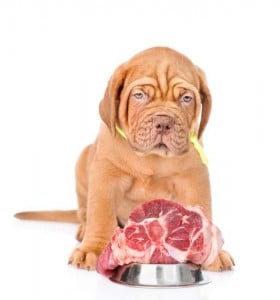 Grain-free dog food means there are no grains in that food, including corn, rice, wheat, soy, and barley.
Grain-free dog food means there are no grains in that food, including corn, rice, wheat, soy, and barley.
Grains are not toxic for dogs, but they aren’t as rich a protein source as animal meats. Dogs are meat-eaters primarily and are best off when they continue that diet.
Many argue that dogs haven’t evolved internally enough to be able to digest and process cellulose and other plant materials, and they cannot efficiently transmit cellulose into glucose the way our bodies can.
Dogs, in general, are not adept at synthesizing and using plant material in their diets to improve their own health.
Canines' bodies aren’t wired that way; they haven’t evolved since domestication in terms of plant digestibility.
Grain-free dog food manufacturers acknowledge that and keep out any unneeded plant materials that your dog couldn’t digest or process.
However, there is some usefulness for grains in your dog’s diet, though that usefulness is limited in scope and shouldn’t be maximized or ingested at high levels.
Contrary to popular belief, grains can be a source of protein for dogs. They’re just not the best source of protein or the largest. Dogs’ internal digestive tracts are short and simply configured; they aren’t meant for a complicated digestion process, and their tracts are woefully unable to compensate for that inability.
Herbivores, by contrast, can synthesize the grains and amino acids in plant compounds.
They easily digest and use the material, which is why they’re able to be healthy while your dog, if he or she went on a herbivorous diet for a non-medical reason, would probably suffer.
To put it simply, grain-free dog food was said to eliminate the unnecessary, “weaker” protein source from the canine diet and focus on produce and meats.
Grain-free dog food also helps dogs with more sensitive stomachs digest the food easily, as grains can make your dog miserable if he or she cannot internalize the food.
However, there are several new research studies, and now the FDA has made note that grain-free diets have been linked to cardiomyopathy.
Vegan dog food
 Vegan dog food is consistent with the properties of veganism, which states that animal products or by-products cannot be ingested.
Vegan dog food is consistent with the properties of veganism, which states that animal products or by-products cannot be ingested.
From an evolutionary perspective, dogs are not meant to eat a vegan diet; however, your dog may have a health issue that requires them to take a walk on the meat-free side.
This does happen occasionally, and there are vegan dog foods out there that can help your dog consume protein while catering to their needs.
You shouldn’t feed your dog vegan dog food without a medical reason. According to most veterinarians, it’s not advisable to do so because dogs, as we’ve stated before, are not meant to eat meat-free lifestyles.
Vegan dog food sources proteins from plant bases such as beans, soy, and other non-meat, non-animal-produced sources.
This type of diet is useful to dogs with allergies to meat as well, and some of the most common allergies in dogs are those of meat such as lamb, beef, chicken, and other meats.
Dogs can also be allergic to eggs, milk, and other animal by-products that a vegan diet addresses.
So, while there isn’t anything wrong with vegan dog food per se, don’t feed it to your dog if they don’t have a medical reason for ingesting vegan dog foods for a prolonged period.
Obviously, if your pooch does have a reason, then there’s vegan dog food out there that he or she will enjoy.
Puppy food
 Some dog foods are specific to puppies.
Some dog foods are specific to puppies.
Growing puppies often require extra nutrition and special attention as they are still developing.
Puppy food manufacturers also refrain from including any ingredients in their puppy-specific dog foods that could harm their sensitive stomachs.
They are still growing and are touchy about harsher substances.
Dog food for puppies is often extra-rich in calcium and antioxidants, both of which are vital in maintaining and promoting healthy growth.
Puppy food is formulated for growth, and that is the key difference to remember when thinking of puppy and adult dog food.
Adult dog food is best for maintenance—you want to keep them in their young, strong condition.
Puppy food has more fats, carbs, and calories, and while some fats are good, the levels that a growing dog needs versus a dog that is already at its appropriate weight are different.
Every dog reaches adulthood at a different time. There are some dogs for whom one year is considered adulthood, whereas others take a little longer. And indeed, there are brands of dog food that work for dogs at all stages of life.
Ask your vet if you should feed your puppy food specific to his or her age group, especially if he or she is still in the weaning stage.
Some puppy foods are great for transitory, post-weaning phases, and some are for puppies transitioning into adulthood. It all depends on your pup’s specific needs.
Limited Ingredient Diet dog food
Dogs can suffer from food allergies much in the same way humans can.
They can also struggle with sensitive gastrointestinal or digestive issues that can make food selection pretty difficult for them (and you).
Limited ingredient diets are restrictive of the major allergy-inducers in dogs, including certain meats, soy, milk, eggs, and other ingredients that can cause an allergic reaction.
The idea behind LID-specific dog food is that it allows dogs to get the same nutrients that they need while also preventing an allergic reaction.
You can tell if your dog needs LID dog food if he or she begins to show symptoms of allergies or discomfort when eating a certain ingredient.
While not all allergic reactions are fatal, you need to get him or her checked out and tested for any signs of allergies, as you wouldn’t want your pet to suffer through an allergic reaction if it was preventable.
In the following section, we’ll talk more about dog food allergies and hypoallergenic dog food, including what the term means and how you can tell if your dog needs that type of pet food.
Dog food allergies are more common among pets than owners think, and being vigilant about possible allergy issues will keep your pet from enduring any discomfort that they don’t need to.
Keep reading to learn more about allergens and preventative measures you can take to keep your dog allergen-free.
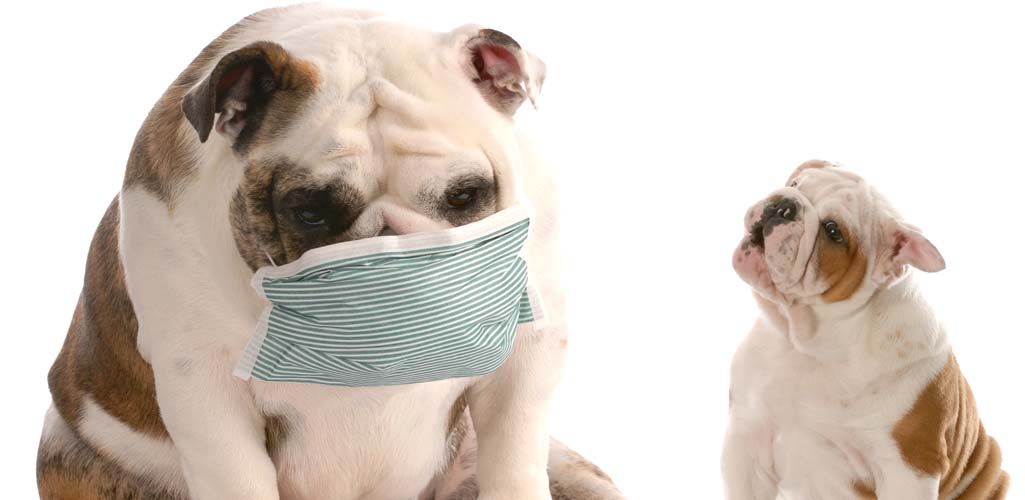
1.4 Hypoallergenic Dog Food
Hypoallergenic dog food is becoming very popular among owners today. The term “hypoallergenic” was coined in the 1950s and essentially means that a product is unlikely to cause an allergic reaction in dogs or an illness related to the ingredients.
“Hypo” is a Greek prefix meaning “Under” or “Below.”
So, hypoallergenic products are below the average risk level for most other items that cause allergic reactions.
In dog food, that translates to ingredients’ hypoallergenic properties.
Hypoallergenic dog foods are usually used with diets that are LID (Limited Ingredient Diets, as we stated in the previous section), prescription diets that are dictated by a veterinarian, and/or “novel” ingredient diets, which refer to diets that are constructed in unusual ways and that contain proteins or other ingredients that are not commonly mainstream.
Novel canine diets provide sources of proteins and nutrients that your dog hasn’t been exposed to before and, therefore, is probably not allergic to.
If he or she can’t eat chicken, maybe they can eat bison meat, for example.
Hypoallergenic diets are necessary for dogs that are unable to consume commercial dog food, though some commercial brands can meet the need for careful consumerism and dietary balance.
According to scientific research, some of the most common allergens for dogs include soy, beef, chicken, dairy, fish, lamb, wheat, yeast, and corn.
These ingredients are actually quite commonplace and are probably eaten by many dogs with no problem when you think about it.
Therefore, allergies that include these foods would likely wipe out a dog’s entire range of food choices.
And that’s where hypoallergenic dog foods come in: their ingredients are sourced and chosen in a way to minimize the risk that a dog allergic to beef protein will have an allergic reaction to animal protein from a more novel animal (such as bison, turkey, or buffalo meat).
But that’s just one example; there are plenty of others that revolve around making sure that your dog is fed appropriately and nutritionally without sparking a problematic reaction.
These ingredients that dogs are most frequently allergic to are the ones they are exposed to equally as often.
This is most interesting because dog food itself actually doesn’t cause allergies the majority of the time. Studies show that only around one-tenth of allergies in dogs are food-related.
Food allergies and intolerances are two different things, and food intolerances are also serviced and prevented using hypoallergenic dog foods. Food intolerances are not allergic reactions to food.
They are digestive or intestinal issues caused by your dog’s system being unable to absorb or digest a certain substance or ingredient.
This food sensitivity in dogs is often mistaken as allergies when in reality, it is just something different.
Hypoallergenic dog foods seek to work their way around these intolerances or food allergies and provide sources of nutrition from things that owners’ dogs have not been exposed to as frequently and cannot build up intolerance towards.
You’ll know if your dog needs hypoallergenic dog food by whether or not they have an allergic reaction or intolerance to the dog food they ingest.
For practical purposes, your dog’s food allergies or food intolerance can both be serviced by hypoallergenic dog foods that will minimize their discomfort and avoid triggering either reaction. We’ll discuss the symptoms of both in the next few paragraphs.
Symptoms of food allergies and allergic reactions in dogs
There are several symptoms of allergic reactions in dogs that you should be on the lookout for if your canine is resistant to a certain dog food type.
Because dogs are like babies and can’t talk to us and tell us what’s wrong, we have to keep a sharp eye out for signs of a problem.
A dog having an allergic reaction may show it topically. They may develop itchy, reddened, scabbed, or scaly skin.
They also might start sneezing and scratching, have itchy ears (if they start rubbing their ears against hard surfaces, that’s a sign of itching or infection), chronic ear infections, watering eyes, reddened eyes, or swollen paws.
Dogs having an allergic reaction can lose hair or develop scabs on their skin. They also may start snoring, which is a sign of throat inflammation. A dog having an allergic reaction can also have more severe symptoms such as vomiting, diarrhea, and dizziness.
On the other hand, a dog suffering from food intolerance will express gastrointestinal distress.
They may vomit or have diarrhea, as they would with an allergic reaction.
They also might have soft stools, bloody stools, bad gas, or irregular bowel movements.
A dog experiencing abdominal pain will whimper and be visibly distressed.
They might also become lethargic and immobile, as being sick will make them not want to move a lot.
To find out what your dog is allergic to, your vet may decide to use a process of elimination diet that results in your dog being put on a hypoallergenic dog food diet.
The vet may subtract an ingredient from your dog’s diet (swap out the beef ingredient for chicken, for example) and see what happens.
After the elimination diet, if the problem is solved, it’s an easy solution. If there’s still some mystery as to what exactly is causing these allergic problems, your vet will probably choose to have your dog placed on a hypoallergenic canine diet that will eliminate those medical problems from his or her diet.
A pet on hypoallergenic dog food no longer has to eat what he or she wants. Hypoallergenic dog foods don’t mean the end of all fun or mealtime enjoyment.
It just requires more conscientiousness from owners to make sure that their dogs are getting the best nutrients for them without any problematic extra results.
Dogs on LID dog foods or other restrictive dog food measurements still need the same amount of nutrients and healthful substances that any other dog does.
They just need to source these nutrients more creatively.
In the next section, we’ll discuss dog nutrition guidelines—who implemented them, why, and how you can use them to select the best dog food for your pet.
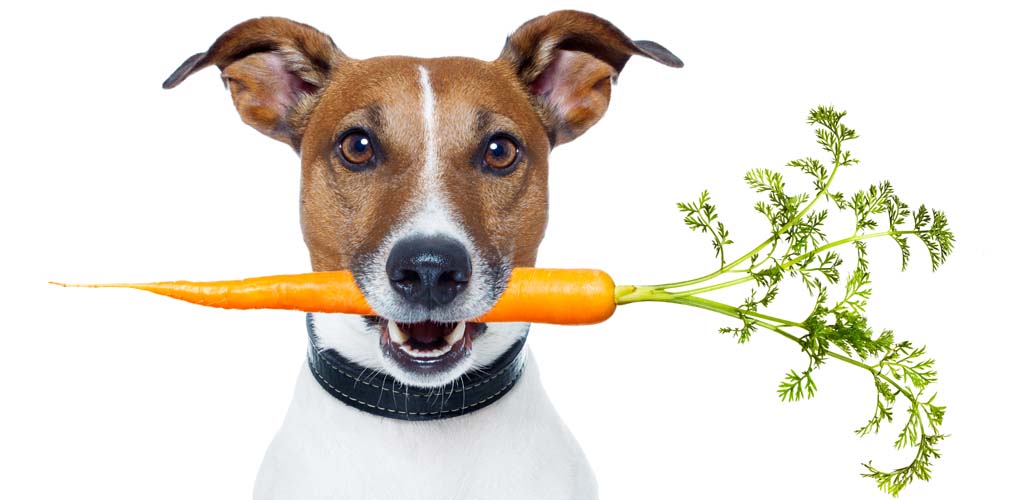
1.5 Dog Food Nutrition Guidelines
The American Association of Feed Control Officials is a nonprofit organization dedicated to setting dog food nutrition guidelines and lobbying the FDA to enforce companies’ adherence to them.
The AAFCO doesn’t have any regulatory authority, and its membership is voluntary.
Still, it has been instrumental in working with the Food and Drug Administration (FDA) and its subsidiary to get nutrition guidelines enforced and adhered to by companies.
Dog food is not immune to its share of charlatans. There are dog food companies out there that attempt to advertise their pet food as something that it’s not.
These Balloon Boy hoax companies manufacturing dog foods are kept at bay by regulatory and governmental departments such as the FDA, which works with advisory from the AAFCO.
The AAFCO wants to ensure consumer safety and the safety of pets and also to open the commercial dog food industry to smaller companies that need a fair shot to make it in the competitive atmosphere that is the pet food industry.
The AAFCO is joined by another organization, the American Animal Hospital Association (AAHA), which assists in organizing the nutritional guidelines for dogs and cats. Both organizations aim to improve food safety and nutrition for pets.
To meet the nutritional standards, dog foods must use ingredients that meet the nutrient profiles and quantities necessary to call themselves “Protein Rich” or for “Growth Development.”
You need to feed your dog a balanced diet, and these organizations provide the know-how and regulatory advice necessary to make sure you have food that can do that in the first place.
The AAFCO’s guidelines included recommended amounts and percentages of each dog’s food intake for growth, reproduction, and maintenance.
Below, we’ve listed these AAFCO requirements for you to observe and remember when searching for the best food for dogs.
Puppy food guidelines
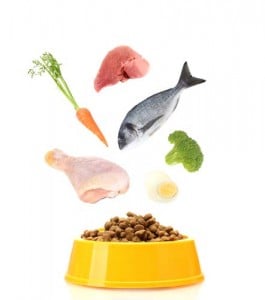 When it comes to puppy foods, owners often try to be particularly careful, and rightfully so.
When it comes to puppy foods, owners often try to be particularly careful, and rightfully so.
For a puppy’s growth and a pregnant dog’s reproductive health, you need to increase the nutritional levels compared to what you would give a grown adult dog to maintain their health.
For a puppy that is growing and developing or a pregnant dog, the AAFCO suggests that their food should contain:
- 22% Crude Protein
- 8% Crude Fat
- 1% Linoleic Acid
- 1% Calcium
- 8% Phosphorus
- 6% Potassium
- 3% Sodium
- 3mg Copper
- 120mg Zinc
- 5,000 IU Vitamin A
- 500 IU Vitamin D
- 50 IU Vitamin E
- 0mg Thiamine
For dog food to label itself “for growth and development,” it needs to adhere to these nutritional guidelines.
Otherwise, it doesn’t adequately fill out the nutrient profile, and it is not allowed to label it as such.
The vitamins A, D, and E are all extremely important, and when scouring the back of the dog food label, you should make sure that those units are what you look for first.
Phosphorus, sodium, potassium, calcium, and other minerals are vital for bone and teeth development and strengthening.
These aforementioned percentages and mg/IU listings are all necessary for the growth and development of puppies, as well as the continued nutrition of pregnant or nursing dogs.
Both of these groups are vulnerable and require extra nutrition and healthful vitamins; it would be unethical for companies to label their dog foods as “Growth and Development” if they didn’t contain these necessary levels.
The AAFCO ensures that no unethical labeling occurs, and they use the help of the FDA and the government to ensure everything is legal among dog food companies.
Adult dog food guidelines
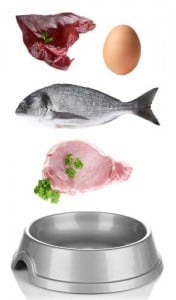 The case for adult dog foods is a little different. For adult dogs, maintenance is the key.
The case for adult dog foods is a little different. For adult dogs, maintenance is the key.
You want to maintain their strength, activity, and general health levels.
The AAFCO has set out a different guideline for these adult dogs’ foods, and this guideline is enforced in the same way that the “For Growth and Development” labeling is.
For a product to label itself for adult dogs, it must adhere to the following nutritional levels:
- 18% Crude Protein
- 5% Crude fat
- 0% Linoleic acid
- 6% Calcium
- 5% Phosphorus
- 6% Potassium
- 06% Sodium
- 3mg Copper
- 120 mg Zinc
- 5,000 IU Vitamin A
- 500 IU Vitamin D
- 50 IU Vitamin E
- 0mg Thiamine
These levels are minimal, making them the base levels to which companies must adhere for them to bill themselves for maintaining adult dog health.
Some of the levels are lower, especially the sodium level.
Too much sodium in a dog’s diet can lead to blood pressure or cholesterol issues, though sodium is a mineral that helps grow healthy bones and teeth.
It’s all about balance. There are maximum levels for this sort of chart—levels at which the company’s food cannot exceed for it to claim that it maintains adult health.
These levels are ceilings that companies should not go above.
The maximum levels for nutrients aren’t listed for all of the aforementioned ingredients above, but they are specified for a few certain ones, such as:
- 250mg Copper
- 5% Calcium
- 6% Phosphorus
- 1,000mg Zinc
- 250,000 IU Vitamin A
- 5,000 IU Vitamin D
- 1,000 IU Vitamin E
Dog food that wants to be used for adult dogs cannot contain levels above those numbers for copper, zinc, calcium, phosphorus, and Vitamins A, D, and E. Overloading these nutrients in pet food can have some very unwanted side effects.
Too much copper, for example, can lead to kidney damage (but not that this is in ridiculously excessive quantities).
Studies showed a long time ago that overloading on zinc, copper and other vitamins can have some harmful side effects for dogs.
Still, the chance of an “overdose” on them is very rare.
I hesitate to use the word “overdose” because that implies that it is something that you can easily do, the way an OD happens with drugs or other harmful substances.
These nutritional guidelines are used to make sure that dog food is adhering to the appropriate amounts.
It is preventative of false labeling and false advertising.
You wouldn’t want to buy dog food for your puppy only to find out that it contained nothing but non-nutritional ingredients and was completely unhealthy.
The AAFCO and its associated organizations ensure that the levels of nutrients in each substance are kept to a high standard and necessary levels, something that we, as consumers and dog owners, can be very grateful for.
In the next section, we’ll talk about common dog food terminology that might confuse first-time purchasers who aren’t sure what the different phrasings and vocabulary surrounding the dog food industry might entail.
I'll help you get acquainted with these terms and names; that way, you’ll be “in the know” when selecting your best dog food—no guesswork entailed.
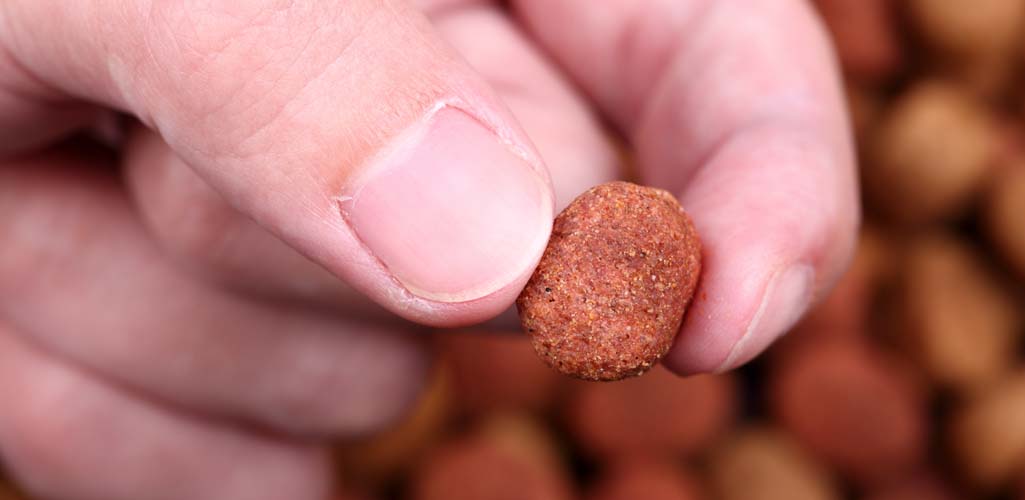
1.6 Dog Food Terminology Explained
There are terms and vocabulary used in dog food products that might be a little alien to those not familiar with these terms and phrases.
Rather than keep you in the dark, in this section, we’ll go over a quick review of what exactly these words mean and what you should know about them when you see them.
The words about dog food ingredients that we’ll define for you are animal by-product, meat and bone meal, meat by-product, meat, poultry by-product, poultry meal, and flavored.
I'll also try to put you into the loop about what it means to be “organic” and “human-grade.”
Animal by-product
Usually used about meat, the term animal by-product means that there are ingredients in dog food that are not necessarily solely from the meat part of the animal.
Once the edible parts have been removed, parts that are not necessarily intended for human consumption are still left.
These parts include stomachs, kidneys, undeveloped eggs, intestines, facial products, feet, backs, bones, livers, fetuses, brains, and essentially everything that isn’t supposed to be consumed by people.
These animal by-products are very controversial, with some people considering them to be disgusting and unhealthy, whereas others don’t see the harm.
Animal by-products are often present in dog food unless the company specifically states that they are not using any animal by-products.
While these BP’s are not fit for human consumption, they are often considered fine for animals to eat.
Many condemned parts that are prohibited from human food are allowed in some dog foods, especially in canned or by-product meals.
The debate over the nutritional quality of meat by-products usage in pet foods is widely contested, though many owners find the thought of such an array of weird body parts to be repulsive.
Mostly, this comes from the idea that “if I wouldn't eat it, then my dog shouldn't eat it as well.”
However, we have to recognize a large amount of emotional reasoning in this rationale, which dogs do not have.
In fact, studies have also shown that by-products are actually non-harmful to dogs and may even be better sometimes than normal meats due to higher concentrations of protein.
The same research also mentions that meat by-products are very important for the pet food market's sustainability.
We want to keep our dogs and cats happy and healthy through proper nutrition without paying insane amounts of money for that food.
Meat-and-bone meal
Meat and bone meal included in dog foods consists of the dried-out products of animal tissues and bones that have been rendered and packaged.
It does not, thankfully, contain horns, hair, hide nail trimmings, manure, stomach content, excess blood, or anything that isn’t meat or bone.
Meat and bone meal can serve as a protein-filled food; it’s almost like “meat concentrate.”
Meat by-product
Meat by-products are of the same definition as animal by-products; this is more specific to meat than eggs or other non-carnivorous food sources.
A meat by-product, once again, is restricted from human consumption, but many manufacturers still include it in their pet foods because they consider dogs’ stomachs more able to digest meat by-products and other unsavory foods than humans, though there isn’t necessarily any evidence to back that up. Again, the topic is controversial.
Meat
Though this may seem like something that does not need to be defined when it comes to dog food, it somewhat does because definitions of meat tend to be pared down to make the dog food companies more able to call their product something that sounds like meat, but actually isn’t.
Meat is defined in dog food as the edible part of an animal.
It is edible in the human sense as well—this does not include the parts of the animal that were listed as being part of the animal “by-products” section.
It only includes what is sold commercially and is packaged commercially for human consumption.
Poultry by-product
Poultry by-product is specific to chicken, turkey, and the eggs that they produce.
Poultry by-products can include beaks, talons, undeveloped eggs, gizzards, giblets, and other bird-specific parts.
This by-product is also often used in dog food as filler content unless the company making the pet food states otherwise.
If they don’t put by-products in their food, they often are swift to share that and immediately label it. Companies know that only meat with no by-products is an attractive selling point for many consumers.
Poultry meal
A poultry meal is made by rendering parts of the poultry and grinding them.
It can contain parts of the poultry such as offal (the internal edible organs), bones, and undeveloped eggs, but the rendered parts are clean. There are no feathers, thankfully, in poultry meal.
The nutritional content is often debated, especially in undeveloped eggs, and studies have shown that poultry meal contains more protein than regular poultry.
However, many pet owners still find themselves squeamish about feeding their dog's butchers’ scraps.
“Flavored”
This is another term that, like “meat,” may seem to be very basically understood, but in the context of dog food, “flavored” can be either artificial or natural.
Make sure to pay attention to whether the food claims it is naturally flavored or artificial.
Artificial flavorings contain chemicals and additives that can be harmful to your dog’s health.
Also, a product that claims it is “flavored” by something doesn’t necessarily mean that it contains that product.
For example, a “chicken flavored” treat doesn’t have chicken in it.
It’s an easy labeling trick to get fooled by; take a little extra time when you’re reading the label to ascertain whether the distinction between flavoring and actual ingredient containment is made.
Organic
Many things out there claim to be organic but actually aren’t.
For something to be organic and have natural products, it has to be over 95% naturally derived with no artificial preservatives, additives, flavorings, or ingredients.
The United States Department of Agriculture (USDA) often certifies companies who claim to be organic, though they do that more frequently with human companies than they do dog ones.
Still, look at the ingredient list on the back of your dog’s food.
If there are ingredients you don’t recognize, that could mean that the food is only labeling itself as organic and, in reality, doesn’t have the credit to back itself up.
Human-grade
Human-grade ingredients in dog food are those that we would eat. Dogs are often given less than human-quality food (not to be confused with table food).
Human-grade ingredients simply mean that we wouldn’t die from poisoning or synthetic substances if we were to eat the food.
No one expects you to eat dog food, of course, but it’s a comforting hypothetical to know that your dog isn’t eating something low-quality.
Speaking of quality, we’ll talk about dog food recalls and what to do about them in the next section.
There are current recalls that you may recognize from the news.
Food recalls are always a little unnerving, so we’ll discuss the appropriate steps to take if your dog food gets recalled.
Chapter Two
Dog Food Issues and Problems
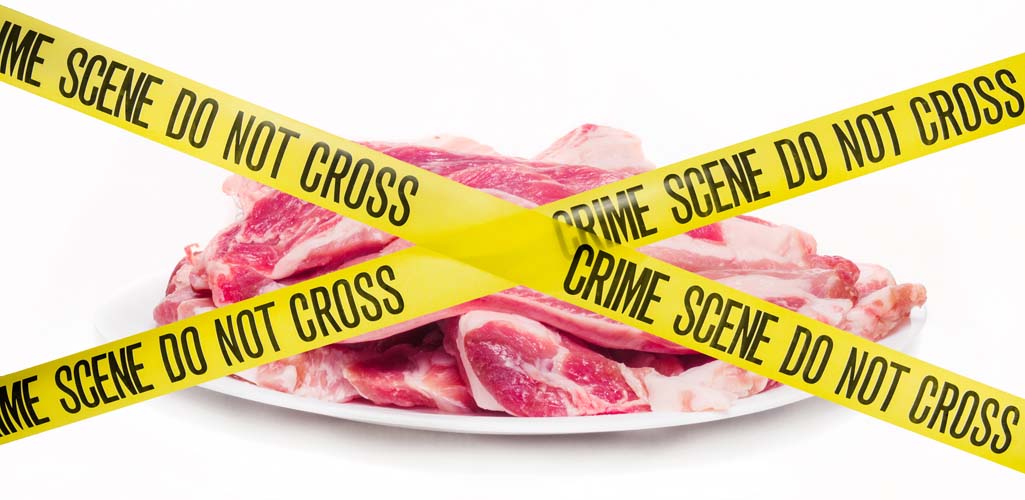
2.1 Dog Food Recalls and What to Do About Them
Sadly, dog food recalls are not uncommon. According to the Food and Drug Administration, A recall is an “action taken by a firm to remove a product from the market.”
The request for product removal can be initiated by the company getting recalled or prompted by an FDA request or an “FDA order under statutory authority,” which refers to a court ordering a company to withdraw its products from the market.
Recalls generally make the news in a major way because they affect many people.
Recalls are published by the FDA, which keeps a log of recent events and recalls on its website so that you can see updates on past incidents and new incidents.
An example of a recall occurred to, say, Nature’s Variety, a company specializing in organic dog food.
Nature’s Variety issued a voluntary recall of their Instinct Raw Chicken Formula because there were concerns about it being contaminated with salmonella (which, as stated in our Raw Food section, is a concern with the raw diet).
Salmonella is a bacterial disease that affects the intestinal tract.
It’s not only a concern for your dog; it’s a concern for you as well because handling raw meat runs the risk of tactile contact with the salmonella, which you can then spread to everything else you touch.
Symptoms of salmonella in pets include vomiting, fever, bloody (or non-bloody) diarrhea, abdominal pain, and lethargy.
Even if your pet is healthy and doesn’t symptomize the illness, he or she can still be a carrier that can infect everyone else in the house.
Nature’s Variety voluntarily recalled all their Instinct Raw Chicken Formula with an expiration date of April 27, 2016.
The recall includes the products with this date and any others that expire before then and are in the bites and patties formation (any pound bag).
So, let’s say that you’re an owner feeding your dog the raw chicken diet—this right here is why you shouldn’t feed your dog raw meat—and this recall pops up. What do you do?
It can be tempting to ignore it, but you really don’t want to do that. The Nature’s Variety recall has not produced any known cases of illnesses yet, but you don’t want your dog to be the lucky number one.
To dispose of a product that has been recalled, you need to follow the handling instructions. Throw it into the garbage bin using gloves and then take the garbage out.
 The disposal method doesn’t just end there. If your product has been recalled, you need to clean the house.
The disposal method doesn’t just end there. If your product has been recalled, you need to clean the house.
Salmonella, which is a common reason products get recalled, is an insidious disease that can get essentially everywhere.
Clean all the surfaces in your home with antibacterial disinfectant.
If you don’t want to throw out the product because you want a refund, check your store’s return policies (all they’ll do is throw it out for you and give you your money back).
It’s important to clean your house thoroughly after this incident because you could be risking contamination otherwise. The food recalls are issued after customers complain of the illness or after an FDA routine inspection of the facility finds that there are trace amounts (or more than trace) of a bacterial contaminant or sterility issue in the facility.
The latter is what happened in the Nature’s Variety case.
It’s important to be very bacteria-conscious for the next few days (Salmonella bacteria can survive for 1-4 hours on outside surfaces).
Monitor your pet’s health closely.
You may want to call your veterinarian, just in case. Let him or her know what has happened with your pet’s food.
This way, they’ll be able to advise you as to what to look for and what steps you should take if you believe your pet is ill.
Also, he or she will be aware of the recall to inform other owners of what has happened.
If your pet begins showing signs of food-borne illnesses, you need to take him or her to the vet immediately. Although salmonella does leave the system after a little while, you don’t want to take any chances. It is a nasty bug.
Keep your dog hydrated and make sure that they have the water supply necessary to handle an infection.
Dehydration is a common side effect of food poisoning, and it’s why there are several cases of the illness that do turn deadly (even though it is not, by nature, a deadly disease).
To recap, if your dog’s food is recalled, dispose of it immediately, clean your house and all the areas that the virus may have touched with disinfectant, and closely monitor your pet’s health for the next week to make sure that they haven’t contracted the virus as a carrier or as a victim.
Continuing along this same vein of doggy food problems, we’ll discuss additives and artificial substances in dog foods and what to do to avoid those next.
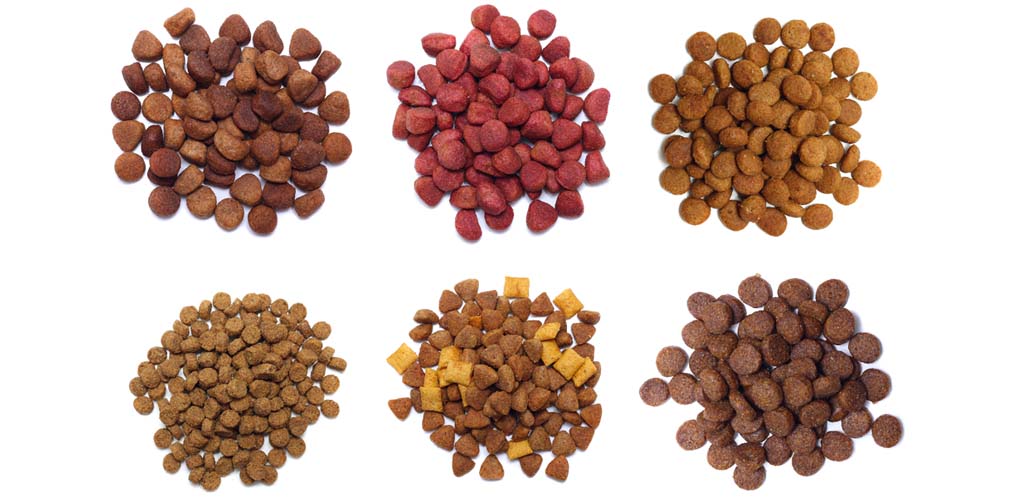
2.2 Additives in Dog Foods
Additives and preservatives in dog food are substances that are artificial and can be dangerous.
This section will discuss the different artificial ingredients in dog food that can harm your pet.
I'll give you an overview of what they are and why you should scour the back of the ingredient label carefully for them and, if they’re not there, take the food and put it back on the shelf.
These substances that you should avoid include preservatives, additives, dyes, and flavorings.
Preservatives
Preservatives in dog food are used to keep the shelf life of the dog food high, therefore increasing the company’s profits because the longer they’re able to sell, the more money they make.
Preservatives can actually be natural, though in some cases, they are artificial.
Preservatives are needed, too.
Dog foods that contain animal fats, an important part of your dog’s diet, are often straightforward to spoil.
While getting rid of animal fats is not a good idea, especially considering that they are vital nutrients, preserving them with fake substances is also a bad option.
Natural preservatives are fine; they’re usually composed of vitamins and end in the words “tocopherol” or “ascorbate.”
These preservatives are considered to be safe and are not a toxic threat to your dog.
Artificial preservatives, on the other hand, are. Ethoxyquin is a preservative that is used in some dog foods.
It is a toxin as well.
Ethoxyquin is also used as a hardening agent in rubber and as a pesticide.
In fact, ethoxyquin is banned in Australian dog foods, and it is also condemned by the European Union.
Ethoxyquin is a substance that is, unfortunately, one of many artificial preservatives used by companies that put profit over dog's health.
The lure of moneymaking has led them to ignore the damage artificiality can do to your pet’s health.
If your dog food contains a lot of ingredients but no tocopherol or ascorbate, there is a chance that it might contain false preservatives instead of natural ones.
Additives
Additives are other toxic substances added to enhance some aspects of the dog food in question.
Glycerol monostearate, phosphoric acid, and propylene glycol are three additives found in some commercial dog foods.
Glycerol monostearate is a thickening agent that also emulsifies and prevents sticking. It isn’t just used in dog food; it also is used in plastic processing and cosmetics.
Phosphoric acid prevents discoloration and is a clear liquid. It isn’t as harmful as the other additives.
Still, it is unnecessary, and a company’s usage of the stuff generally tends to indicate that the dog food is low-quality and cheap since it is discolored to the point of needing an actual discoloration inhibitor.
The third common additive, propylene glycol, is used as a humectant and prevents kibble from becoming too dry.
Propylene glycol is banned by the European Union as a food additive, and it is toxic when consumed in large amounts (or day after day, the way your dog will). Avoid that ingredient completely when purchasing dog food.
Dyes
Dyes have long been a highly inadvisable ingredient for consumption not only in the food world but in the cosmetic and facial industry as well.
Dyes are found in dog treats in most cases, though they are also there in dog foods.
Yellow 6, Blue 2, and Yellow 5 are the biggest culprits, with Red 40 and Titanium Dioxide finishing off the list as inconclusive yet unneeded dyes.
Dog food dyes are not necessary for taste or nutrition.
They are solely there for an aesthetic appearance, which is senseless because a food’s color doesn’t matter—it gets dissolved by the stomach acid regardless of the color.
Yellow 6 is the substance that has been the most conclusively determined as toxic, though the others are still up for debate.
Animal tests with Yellow 6 determined that the dye is causally linked to tumors in the adrenal gland and kidneys.
While Yellow 6 is not harmful to humans, it is harmful to animals, a group that your dog is part of.
This dye is also found in trace amounts in certain carcinogens.
This dye also can cause allergic reactions (as can the others), so it is best to stick to natural coloration in food.
Pay attention to the content in dog treats, as those tend to be the substances that most frequently have the dyes in them.
Flavorings
Flavorings in dog food are great, and they’re perfect for older dogs whose olfactory senses are diminishing and need a little extra assistance.
However, flavorings derived from artificial substances are toxic and can damage our pet’s health. Some commercial pet food companies spray their product to make them more enticing.
The artificial flavoring is really nothing more than attractive-smelling chemicals that taste vaguely like the meat they are supposed to be imitating. Another attempt made by companies is to enhance the flavorings.
These flavor enhancers are generally not easy to digest, making the food feel greasy and not adequately digestible, making your pet’s stomach hurt.
Artificial flavorings aren’t used as often in dog foods as in treats, though they’re still a presence to watch out for because of their inability to be digested and general falseness.
A product can be labeled as “flavored” if the dog can detect the taste. So food can be called “chicken flavored” if, to your dog’s taste buds, it is detectable.
There is no organic requirement for calling something flavored.
To tell if something is naturally flavored, check to see that the label says “Made with Natural Flavors.” The AAFCO, thankfully, has put in place guidelines that prevent labelers from fibbing about their products.
Most dog food companies are proud that their pet foods are naturally flavored because they know that that is a draw to artificiality-shy consumers. Thus, if the label says that, they are probably telling the truth.
In the next section, we’ll continue the theme of food safety by discussing other measures to take to ensure that your dog’s eating experience is as safe and enjoyable as possible.
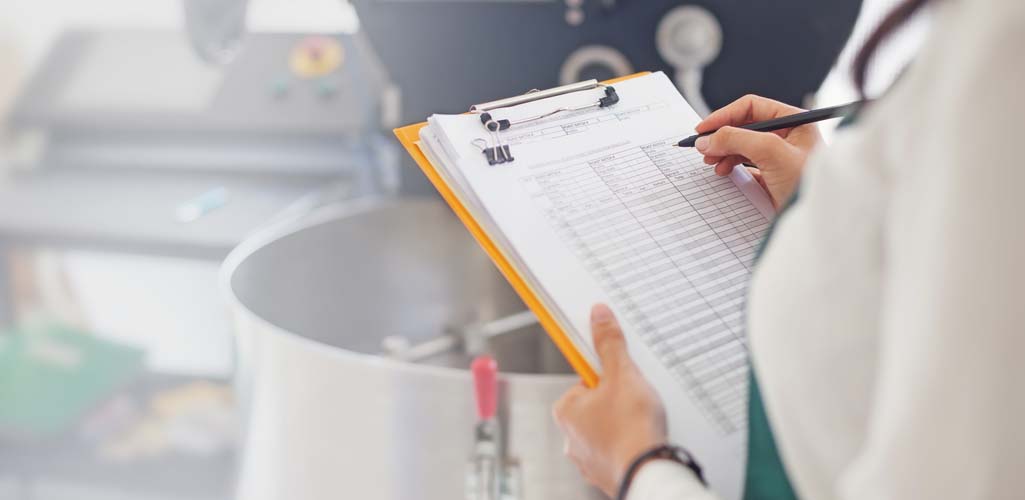
2.3 General Dog Food Safety
In general, there are things that all pet moms and dads should know about dog food safety that, if acquainted, will make sure their dogs are as safe as possible when chowing down.
One of the main things that responsible pet parents should know is how to recognize food-borne illnesses.
We’ve touched upon this before, briefly, in earlier chapters.
Still, there are dog food illnesses out there that dog food recalls may not give you all the information on, and if you’re buying raw dog food as part of the ancestral diet, you’ll need to know about to make sure that you’re acquainted with what to recognize and what to do.
Food-borne illnesses such as food poisoning, salmonella, botulism, and E. coli are all distinctly recognizable by the symptoms that they possess.
Dog food poisoning
A plethora of different bacteria types can cause food poisoning.
Food poisoning happens when food is contaminated by bacteria and then ingested by your dog.
This can come from raw meat, contaminated vegetables, mold, or other foreign biotics that have made their way onto the food and into your dog’s digestive tract.
Dog food poisoning is not uncommon in dogs because dogs tend to be indiscriminate about what they eat.
You’ll be able to tell that there is something wrong within three hours of consumption.
Vomiting, lethargy, diarrhea, abdominal pain, and dehydration are all common symptoms of food poisoning. Call your veterinarian immediately.
Unfortunately, food poisoning has to ride itself out of your dog’s system and can’t be eradicated through medication (though the symptoms can be helped if needed).
Make sure you have plenty of water around, as the loss of liquid through diarrhea and vomiting will leave your dog in need of hydration.
Salmonella
As we discussed before, salmonella is an intestinal tract bacteria often found in contaminated raw meats and produce.
Salmonella is also known as salmonellosis, and it can be transmitted to humans if we don’t act quickly and appropriately to recognize and handle the infection.
In addition to vomiting, diarrhea, and stomach pain, symptoms of salmonella include swollen lymph nodes, weight loss, dehydration, fever, shock, lethargy, fast heartbeat, mucus in the stool, and skin disease.
Pregnant dogs may miscarry. Salmonella requires immediate medical attention.
Take your dog to the vet as soon as you believe he or she may have contracted the disease.
Handle your dog with rubber gloves and try not to come into contact with his or her bodily fluids.
Botulism
Botulism is something many people are not familiar with, as it’s not as common as the term “food poisoning.”
It is rare but serious enough that it bears mention.
It comes from the ingestion of raw meat and animals that are infected with the bacteria.
Symptoms manifest within a few hours or a few days of the bacterial contraction.
Botulism can be serious, though most dogs aren’t susceptible to the more deadly symptoms of the disease.
At its worst, botulism can cause paralysis.
Symptoms include weakness or paralysis of all four limbs, usually within the first 12-24 hours of botulism contraction.
A botulism-infected dog might feel a sense of weakness in his or her hind legs that spread from there throughout the rest of the body.
Immediate veterinary care is required to handle an infection of this sort.
Escherichia coli
Escherichia coli, or E.coli, has been found in several pet foods that have since been recalled. It has also been found in some human foods as well.
The bacteria are usually present in the lower intestine and are generally benign, though, in the case of food poisoning, they are much more dangerous.
E. coli causes weakness, lethargy, diarrhea, cold skin, lowered body temperature, blue gums, nostrils, lips, and other mucous membranes, dehydration, refusal to eat, and vomiting.
If you suspect your dog may have E. coli, you need to call the veterinarian at once, as, if left untreated, the disease can grow worse.
In addition to dog food ingredient concerns, you can spot-check your dog food to make sure that it is not spoiled or bad. Make sure to check for mold when you open the dog food bag.
Occasionally, something goes wrong at a company’s facility, and that ends up impinging quality control for the rest of the food.
If you discover this has happened, throw out the food and call the customer complaint line.
This way, you’re informing the company of what happened, and they will likely refund your money and issue a recall.
Another pet hazard is choking. Choking is not common in dogs because they are not set up the way that humans are.
However, choking is a concern that deserves note because you will need to know what to do in case your dog experiences this.
If you suspect your dog is choking, you’re going to need to perform a doggy version of the Heimlich maneuver.
For a large dog, stand behind him or her and place your arms so that you are making a fist against the end of the sternum (thumb touching the skin).
With your other hand clasped over the first, thrust upwards and forward towards your dog’s shoulders to force the foreign object out of their windpipe.
For smaller dogs, you can hold them with their spine against your chest.
Place your fist against the end of their sternum and thrust upwards and forward.
This will help get the projectile out of their windpipe.
You may need to clear your dog’s airway as well by opening their jaws and doing a physical swipe for any blocked particles there.
Safety concerns are a viable part of a pet owner’s life, and hopefully, these tragedies and illnesses will never befall your pet. But, it is important to make sure that you know what to do in the case of these illnesses.
In our next section, we’ll discuss something a little less bleak: how to pick out dog food (much happier than the gloom and doom of accident discussion).
Chapter Three
Choosing the Best Dog Food for your Dog
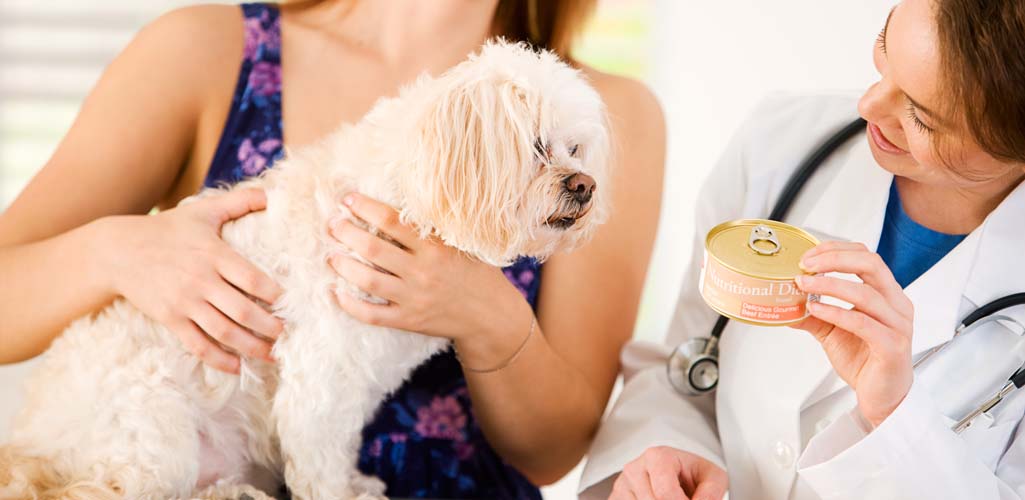
3.1 Picking Dog Food Wisely
When selecting the best dog food, you want to make sure that you are familiar with the different aspects of your pet’s health that matter in the selection process.
All dogs are different, and their health levels vary as well.
When selecting the best dog food, you may want to consider taking your pup to the vet beforehand and getting him, or she checked out to make sure that all of their health needs are available to you and that you know what they may require in terms of illness, digestive problems, and weight concerns.
While dogs are generally quite capable of digesting food, some concerns should be noted, particularly in activity level, health, age, and dietary needs.
Veterinarians are often able to recommend certain foods for your dog if he or she requires extra attention in terms of one food group area.
There shouldn’t be a need for vitamin supplements for your dog unless you are directed to do so by a veterinarian.
Activity level
Your dog’s activity level is important in determining the type of dog food they should eat.
Dogs working (police dogs, therapy dogs, and other occupational animals) need more protein and calories than dogs with just an average activity level.
Working dogs burn off more calories than they consume, which, while good for weight loss, is energy-draining on an otherwise in-shape animal that does a lot of activities.
Increasing the protein and fat intake of these dogs will provide them with the subsistence necessary to do the job they’re required to do.
Fat and calorie intake, while it can cause trouble for inactive or lazy dogs in terms of weight, is necessary for dogs to keep their energy enhanced.
Carbs are also an important part of an active dog’s diet, as they, in addition to fats, are vital sources of energy that keep dogs (and people) going throughout the day.
On the reverse side, dogs that are inactive because of a health restriction, disability, or general laziness need to intake fewer fats, carbs, and calories because their lifestyle doesn’t require an elevation of energy.
In fact, it requires less because if fed too much, inactive dogs will gain weight, and that weight gain can have serious ramifications on their health.
Taking an honest look at your dog’s activity level before purchasing dog food will give you a solid way to measure whether or not your dog needs extra quantities of a nutrient.
If you plan to increase his or her activity level, you can adjust accordingly, but make sure the increase in exercise happens.
Health
A dog with chronic illnesses or injuries will also need a specialized diet that your veterinarian can recommend. Nutrients are nature’s first source of healing, and dietary aids are no exception.
For example, for a dog that has chronic eczema, a food that is high in Omega-3 and Omega-6 fatty acids, is a beneficial idea because those fatty acids promote skin and coat health.
Dogs that are anemic or underweight also need a diet that can help them gain weight and retain strength.
Health needs can be improved upon by a diet that is structured to fill those needs.
If necessary, your veterinarian can prescribe supplements or a diet that is sufficient in the nutrients that your dog is lacking or needs more of.
Age
Puppies, adults, and elderly dogs need different types of food in different quantities. Newborn puppies still in the weaning phase will eventually need dog food to help them grow stronger and larger successfully.
Puppies’ diets are rich in calories, fats, carbs, and other substances that promote weight gain and fat intake, as they need extra sustenance to preserve their health and vitality.
Sickly puppies may need even more nutritional supplements to make sure that they make it through puppyhood okay.
Adult dogs require maintenance, as they are in their prime and need to keep their energy and caloric levels at their current state to remain healthy.
Elderly dogs are frailer and require food that won’t irritate their digestive system and provide the health they need to remain strong even at their age.
Dogs can grow old gracefully; they just need a little help from us to help them do so.
Dietary needs
As we covered in a previous section, allergies and food intolerances aren’t uncommon among dogs.
Dog allergies are not unheard of, even for the primary ingredients in many dog foods today.
While that might be an inconvenience to you and your dog, there are ways around it that can still provide the adequate nutritional levels needed for your dog despite their gastrointestinal and stomach problems.
Finding out what is driving the dietary problems can be discovered through an elimination diet, or you may be able just to switch the food and not have to go through the process of elimination to find out which substance is the one that is causing all the problems.
If you believe that your dog is having a bad reaction to food, talk to your veterinarian about it immediately to decide what you should do.
Monitor your pet’s behavior closely, as it might not be the food you are feeding him or her; it could be the treats, too.
Dogs’ systems are finicky that way, and since dogs can’t talk (obviously) and tell you what the problem is, it’s up to us as owners to figure out what’s wrong.
In the next section, we’ll discuss the basic nutritional categories that are vital in choosing this dog food—i.e., what makes your dog “tick.”
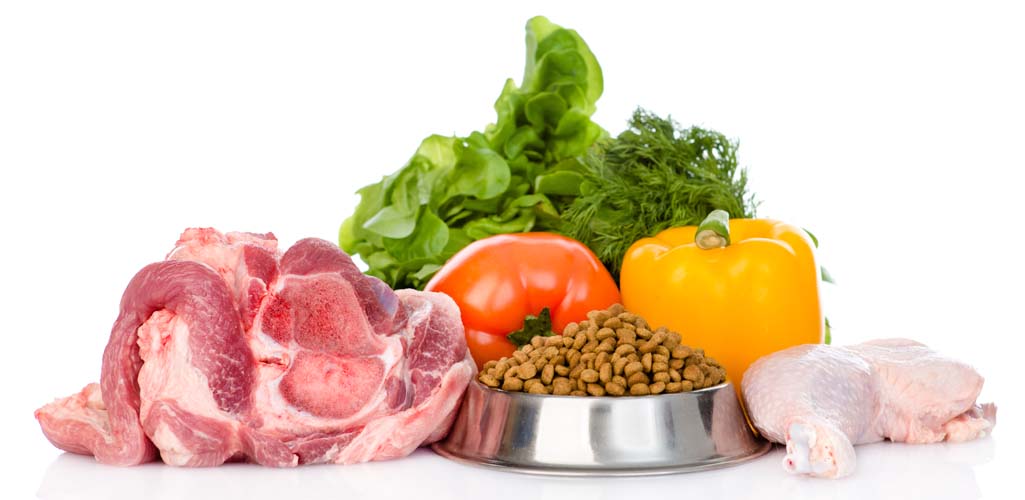
3.2 The Most Important Dog Food Ingredients
There are six main nutrient groups that you need to make sure your dog’s food hits.
Otherwise, they won’t get the nutrition they need, and you will have to run back out to the store to figure out new food.
Cut down your trial-and-error time and get the high food in the six nutrient groups to start.
These important groups are vitamins, minerals, fats, carbohydrates, protein, and water.
Below, we’ll give you some information on just what each of those categories does for your dog’s health and why they are vital to his or her lifestyle.
After that, we’ll tell you more about fruits and vegetables and why they’re also important, even though your dog is, technically, a meat-eater.
Vitamins
Vitamins are one of the more well-known nutrient groups, and if asked to name the most important components of a person or animal’s diet, the first thing that would probably pop into your head is “vitamins,” and for a good reason. Vitamins are catalysts for enzymes.
Enzyme reactions are what promote healthy metabolic functioning. For your dog’s metabolism to function properly, he or she needs doses of vitamins such as A, D, K, and E.
The recommended minimum dose of Vitamin A for dogs is 2272IU. This vitamin promotes muscle growth, skin and hair health, and proper liver functioning.
It is found in foods such as fish oil, vegetables, dairy products, and liver.
Vitamin A is essential for puppies because it is a growth accelerator and muscle-strengthener.
Vitamin D, the sunshine vitamin, is recommended for a minimum dose of 227IU. Vitamin D regulates calcium and phosphorus levels in your dog’s bloodstream.
It helps bones form and maintains healthy nerve control. It also strengthens muscles.
This is another vitamin that is especially important for puppies (though it’s important for all ages of dogs) and it is found in fish, dairy products, and sunlight.
Vitamin K is synthesized in your dog’s body, so there isn’t a need to check labels for vitamin K supplementation.
Vitamin K promotes normal, healthy blood functioning.
It’s so important, in fact, that the scientist who discovered Vitamin K, Dr. Henrik Dam, won a Nobel Prize for it back in 1929.
Bacteria in the intestines create vitamin K, so the actual amount that your dog needs is unclear.
However, if he or she has a vitamin K shortage or deficiency in production, your vet will probably give you medicine for him or her to take.
Last but not least on our list is Vitamin E, and it's recommended at minimum levels of 23IU. Plant oils are the richest in this vitamin.
Vitamin E keeps the cells of the liver, heart, skeletal muscles, and nerves functioning and in good, effective condition.
Without it, your dog will suffer from a bodily breakdown, and deficiencies can cause “Brown Bowel Syndrome,” which is a nasty condition in which your dog’s bowels hemorrhage and ulcerate.
Minerals
Minerals are inorganic compounds that are not naturally synthesized and produced by your body like vitamins are. They don’t produce energy either.
Instead, they have to be provided in your pet’s diet for him or her to make sure that they receive enough.
Minerals help your dog’s bones and teeth; they’re structural aids. They also help the body retain fluidic balance and homeostasis.
Minerals are also found in metabolic reactions.
Minerals include calcium, phosphorus, sodium, chloride, potassium, iron, copper, and others.
Fats
Fats are not the boogeymen that diet magazines have made them out to be. They’re important in humans and just as important in dogs.
In dogs, fats are a primary source of raw, natural energy.
They provide more than two times the energy of carbs or proteins, and they also help absorb and process vitamins in a way that makes them as beneficial as possible.
Fatty acids improve skin and hair health in dogs, and other acids, such as linoleic acid, reduce the chance of skin issues and hair problems.
Without fats, vitamins wouldn’t be absorbed and used, and your dog’s hair and skin health would suffer.
That’s why many supplements for dogs today are fatty acid supplements; companies know the benefits associated with such energizing compounds.
Carbohydrates
Carbs help the body’s intestines in their daily functioning.
They also are a source of energy for the body’s tissues and provide glucose to its organs, most importantly the brain.
Fiber is a form of carb that can help regulate loose bowels or diarrhea.
Beet pulp, a fermentable fiber that is often included in dog foods, is one of the best sources of carbohydrates, as they helps regulate your dog’s digestive system and keep their gut functioning great without being hard to digest the way other fibrous sources that have grains in them are.
Protein
Proteins are a vital substance for improving your dog’s health and making sure that he or she has the energy required to go through the day.
Proteins are the building blocks of all of your dog’s cells, tissues, enzymes, antibodies, hormones, and organs.
They are vital for the growth, maintenance, repair, and general functioning of all of your dog’s organs and tissues.
Amino acids are the building blocks of those building blocks, and the essential amino acids that cannot be synthesized in your dog’s body must be provided in his or her diet; otherwise, he or she will have serious health ramifications and issues that stem from an amino acid deficiency (such as a breakdown of the body’s systems).
Water
Hydration is the key for all living beings. Your dog’s body weight is 60-70% water.
Canned food, especially, has a lot of moisture in it. It is almost 78% water for some brands. But even though wet food has water, you still need to make sure that you have a clean source of water available for your dog at all times.
Dehydration can cause serious illness, so to prevent that, make sure you’re paying attention to your pet’s water levels.
 Fruits and vegetables are two aspects of your dog’s diet that aren’t credited enough with being vital.
Fruits and vegetables are two aspects of your dog’s diet that aren’t credited enough with being vital.
Dogs are considered meat-eaters, so fruits and veggies likely aren’t high on the list of pet foods to buy.
However, fruits and vegetables contain vital minerals and vitamins for dogs, carbs, and other nutrients that have to be provided in your dog’s diet.
Here are the top five “super fruits and veggies” that you should make sure his or her food includes.
Spinach
Spinach is a powerful vegetable for your dog. This leafy, green veggie is high in iron, which your dog needs to promote healthy blood functioning and immune system health.
It also is considered to be a superfood for humans, as it helps ward off cardiovascular ailments and sicknesses.
Since the 12th century, spinach has been a true powerhouse in the pantheon of the veggie and fruit world. It is rich in vitamins A and E and also contains fiber, zinc, calcium, and other heart-healthy nutrients.
Blueberries
Blueberries are another superfood, and they contain DNA-protecting and fat-burning substances that will protect your dog’s immune system and heart health from the dangers of free radicals.
Blueberries have tons of antioxidants and are low on the glycemic index, meaning that they won’t increase your dog’s blood sugar level.
Apples
Apples are another approvable people's food that dogs can partake in, either as a quick apple-slice snack or in their kibble or wet food.
Apples are a fantastic source of fiber, which helps regulate the digestive system and intestines, promoting healthy bowel movements and digestion.
They also have vitamins A and C, which are necessary for building strong bones, teeth, and muscles.
Pumpkin
While this probably won’t be a food that you’re going to slice up and hand your dog, you can find pumpkin in some organic dog foods.
Pumpkin has tons of benefits for your dog (they aren’t just Jack-O-Lanterns, you know!) because they are rich in antioxidants, fiber, vitamin A, and other heart-healthy substances.
Pumpkins can aid in alleviating bowel movement problems, and their antioxidants protect cellular structures in your dog from devolving.
Sweet potatoes
Though regular potatoes are fine, sweet potatoes are chock-full of vitamins E, A, C, and B-6.
They also have many antioxidants that help boost your dog’s immune system.
Sweet potatoes contain calcium, thiamine, iron, folate, potassium, copper, and other minerals.
(Minerals, remember, are not synthesized by your dog’s body and need to be provided in the diet—sweet potatoes are a way to do that).
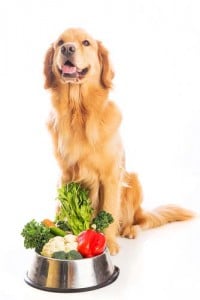 Vegetables and fruits are superfoods that will ensure that your dog receives the vitamins and minerals that he or she needs.
Vegetables and fruits are superfoods that will ensure that your dog receives the vitamins and minerals that he or she needs.
But, when it comes to animal protein and animal-derived amino acids, meat is the best way to get that.
Different meats, both novel and commercial, have different important benefits that will help boost your dog’s health and immune system.
Knowing the different meat’s qualities and strong points is beneficial when deciding what you want to feed your dog. The meats most often seen in dog food are chicken, beef, bison, salmon, and turkey.
Chicken
Chicken, first and foremost, is incredibly high in protein.
It is one of the most commonly used ingredients in commercial dog food and is especially good for building lean muscle and keeping down fat deposits in your dog.
Chicken also contains calcium, which fights off bone weakness, as well as vitamins A and B-12. It also has a high count of potassium, which is a mineral vital to building bone and muscle strength.
Beef
This heavyweight protein is also high in potassium and has an excellent count of vitamins B-12 and B-6.
Beef has iron and magnesium in it, both of which help bone growth and muscle maintenance.
The beef comes from cattle, and when selecting it (as with all meats), you want to make sure that it isn’t injected with antibiotics, steroids, or any other hormone that could harm your dog.
Bison
Bison is a novel ingredient, meaning it is used for dogs that aren’t exposed to it the way they are to chicken and beef and, therefore, aren’t allergic. It is a component frequently seen in LIDs and is low in fat.
It has one of the highest protein counts of all meats out there on the market right now, and its smoky flavor will make it a hit with your dog.
It also has a low cholesterol account when compared to other types of meat. Nutritionally, it is an amazingly high source of vitamin B-12.
Salmon
Salmon is high in protein and high in fatty acids such as Omega-3 and Omega-6, both of which promote healthy coats and skin in dogs.
They have an astronomical B-12 and B-6 count, and salmon oil is often used as a supplement for dogs that need an extra boost of healthy fats and vitamins.
Salmon oil also has potassium and magnesium, which are minerals that protect cell structure in dogs.
Turkey
Turkey is considered by some to be a more novel meat in the production of dog food, though others think it’s a commercialized enough ingredient.
Either way, it is very healthy for your dog.
Turkey is high in protein and low in fat, and it is also a fantastic source of iron, B-12 and B-6, phosphorus, potassium, and zinc, all of which are necessary for the immune system functioning in your dog.
Now that you know the different foods and nutrients that are necessary for your dog to live a healthy, happy life, you should select a food that contains some combination of ingredients that will both fill out your dog’s nutritional profile as well as make him or her look forward to mealtime.
Different breeds ingest different foods, however, so what you buy your dog can be (but doesn’t have to be) dependent on his or her breed, if he or she has the health problems or risks associated with his or her type of dog.
Size is also a factor in food consumption, as we’ll show you in the next section.
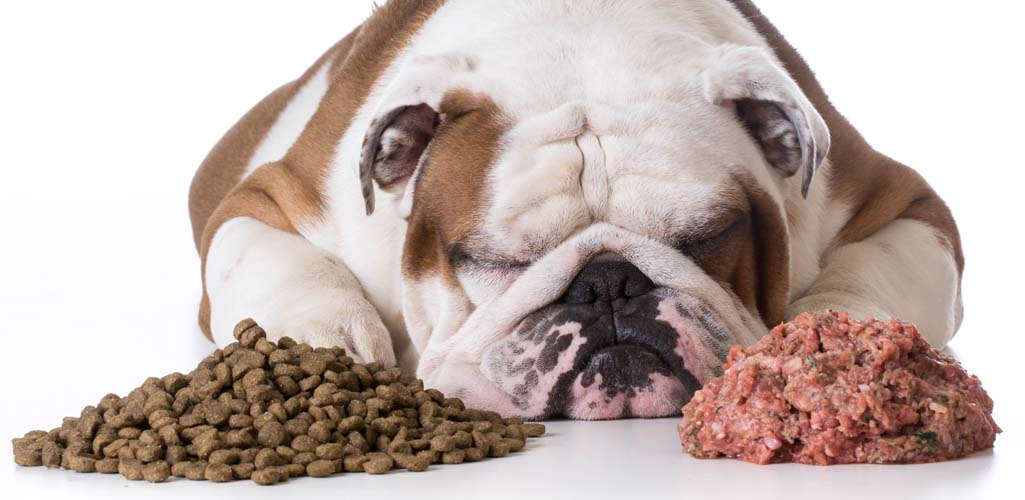
3.3 How to Pick Dog Food Based on Breed and Size
Different breeds and different sizes of dogs have health concerns and requirements that are unique to them.
It is possible to choose your dog's food based on the breed of the dog that you are selecting.
Often, the larger breeds of dogs need different nutrition than the smaller breeds because of their immense size and food intake. Larger breeds of puppies have the potential for growth problems stemming from their massive sizes.
They can suffer from hip problems and joint, skeleton, and muscular issues as well.
Large dogs put a lot of weight on their bones, and for some, that weight catches up to them and causes a risk of problems such as arthritis, osteoporosis, and hip dysplasia, which is when the hip joint falls out of the socket and makes walking, running, and other physical activity incredible difficult for your dog.
To reduce the risk of skeletal issues or muscular problems, you need to make sure that you’re feeding your breed the recommended amount of calories, protein, and nutrients to keep their strength and growth accelerating at the same rate.
Breeds such as Great Danes, Mastiffs, and St. Bernard dogs run the risk of these bone and joint problems.
Select foods that are extremely high in protein. Protein sources should come from animals such as chicken, beef, bison, or others that we discussed above.
Protein will help your dog’s joints, muscles, and bones form correctly and increase lean muscle buildup.
Other substances to look for include glucosamine and chondroitin, which are useful in the construction of muscle and joint health.
Chondroitin also helps ligaments, which hold the bones together and need extra strength when connecting the bones of such a large, fit dog.
You also want to make sure that the food you are selecting is high in fatty acids such as EPA and DHA (respectively: eicosapentaenoic acid and docosahexaenoic acid).
These acids are not only great for skin and coat health; they also are muscle increasers and joint strengtheners, as well as fighting canine arthritis, according to many studies.
Weight issues can be an issue for larger breeds of dogs, as owners tend to overshoot their nutritional goals to compensate for their large sizes.
It’s often a tricky balance that needs to be reached between attaining the nutritional goals and maintaining a healthy weight.
To ensure that your dog stays in shape while also getting enough to eat, make sure he or she exercises regularly for at least thirty minutes a day.
If the weight becomes a real problem, you can discuss going on a low-calorie or low-fat diet with the vet.
In the next chapter, we’ll discuss the different considerations that each dog needs. Keep these in mind when selecting dog food if your dog falls into one of these categories.
Chapter Four
How do know what’s best for different dogs?
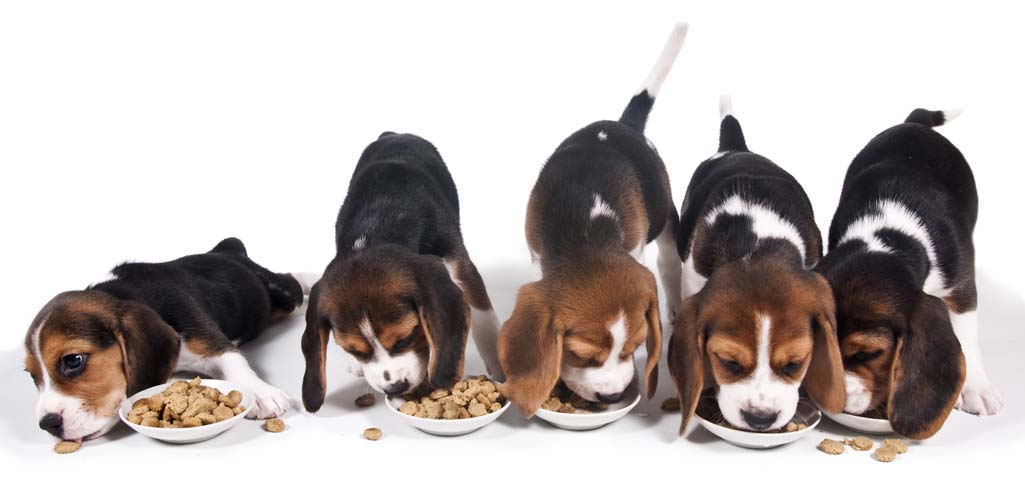
4.1 Puppies, Adult Dogs, and Seniors
Though discussed briefly in the last few sections, it’s important to note the difference between puppies, adult dogs, and elderly dogs regarding their food needs requirements.
Aging changes the physiology and psychology of dogs, and the food you buy for them needs to reflect that.
Puppies are still developing.
At first, they will be weaned off of their mother and won’t be able to chew solid food, but eventually, that weaning will stop, and they will need to look at some puppy food.
There are tons of puppy brands out there that pet parents love, and many of them are geared towards the burgeoning health of young dogs.
Puppies require extra nutrition: fats, calories, and proteins to keep them growing at a sturdy, strong rate. You should balance puppy foods with a healthy diet in mind.
They should be high in protein, natural fats, and oils and derived from animal proteins such as chicken, beef, or another actual animal. Puppy food should not come from meat meals or meat by-products.
High-quality puppy food has meat in it, and that’s it; there’s no finagling around that or “by-product” listing on the ingredients column. Puppy food should also have no preservatives, dyes, or artificial substances, such as those we listed a few chapters ago.
This organic naturalness goes for all dog foods.
However, it is vital for puppies that are still developing and who can really be harmed by the intrusion of artificiality on their delicate systems.
If a puppy is a large breed, you don’t want food overloaded with calcium. Though this may seem counter-intuitive, too much calcium in the diet doesn’t allow the bones to strengthen naturally, leading to hip or joint problems when the puppy is older.
Also, don’t free-feed your puppies. Keep them on a set eating schedule; don’t allow them to meander back and forth from their food whenever they want to.
This can cause weight gain and lethargy, two things that you do not want to have in puppies that young.
Weight gain, even at such a young age, can have ramifications that extend into adulthood for puppies.
Give your puppy amounts that are measured precisely (the food you’re serving them usually comes with instructions), and keep them on a feeding schedule.
This also benefits you, as if puppies get off a schedule, they can be challenging.
They’re like babies in that way. The structure is crucial to raising a puppy and making sure they understand their role in the house, including at mealtimes.
Adult dogs are less complex than puppies because, as mentioned in a previous chapter, they’re more about maintaining and keeping their existing systems healthy and in shape.
Adult dogs do need to be fed on a schedule; scheduled feeding is important throughout your pets’ lives, no matter what their ages are.
By keeping your dog on a schedule, you reinforce that you make the rules, not him or her.
Your adult dog can be fed on a few different types of plans, as detailed by the ASPCA.
You can feed him or her by the timed method, the portion control method, or the free feeding method.
The timing method of feeding your dog is like clockwork (literally).
In this system, you fill your pet’s bowl with a certain predesignated amount of food and leave it for them during a set time per day.
That time period can be half an hour, an hour, or whatever you feel is necessary.
Make the food known to your dog; bring him or her over to it and make them aware that it has been placed out for them.
If the dog food hasn’t been consumed in that amount of time, remove it. This way, they know that time constraints have been placed on their feeding.
This is one of the most structured approaches to take to feeding your dog, and it is popular among people with dogs who need extra discipline or behavioral training.
The portion control method of feeding works in somewhat of the same way as the timed feeding method, except with portion control, you measure your pet’s allotted food intake and offer it to them at set intervals during the day.
You don’t necessarily have to remove the food if they don’t eat it. This is good for either underweight or overweight dogs who need a little extra help reaching their goal weight.
It’s a disciplined way to achieve either weight loss or weight gain with your dog while also allowing them to keep their eating portions intact.
The last method, the free feeding method, entails leaving out food during the day and letting them come and go as they please.
The food can be in the portion control method, but you allow your dog to eat whenever they choose to.
Obviously, this method works best for dogs that eat kibble because wet food spoils so easily that leaving it out all day would not work.
Whatever method you choose, remember that you are the owner, and your dog’s feeding schedule is up to you and you alone.
Don’t allow him or her to turn the adorable puppy dog eyes onto you and wheedle some extra food out of your hands.
While it’s tempting to do that, remember that you are in charge and that breaking a feeding schedule or getting lackadaisical with your portion control can really harm your dog in the long run.

4.2 Dog Allergies
Canine allergies are topics we covered extensively earlier, but we didn’t explain different examples of alternative foods that your dog can eat.
Hypoallergenic dog food is manufactured to provide nutrition to a dog that otherwise couldn’t get from other commercial foods.
Hypoallergenic dog foods tend to contain certain ingredients that are low-risk on the doggy allergy scale.
Some of the most common ingredients found in dogs' diets with allergies include bison, potatoes, blueberries, sunflower oil, and kale.
Bison, a meat that is rich in protein, low in fat, low in cholesterol, and high in vitamin B’s, is a novel food, meaning that because your dog hasn’t been exposed to it, he or she won’t have an intolerance for it the way that they have the other meats such as chicken and beef.
Bison is a game-y meet, but the roasted and smoked taste of it will win your dog over in a heartbeat.
Bison has 200 calories in a four-ounce serving, which is comparatively less than the other meats.
It also tends to be leaner. Bison are hunted yearly, and almost 20,000 of them are killed.
This might seem sad, but in reality, they are overpopulated and would have died anyway, so why not use their nutrition instead of letting them die from starvation?
Bison meat is often combined with potatoes, another ingredient that has become very common in dog foods.
Potatoes, both sweet and regular, are a strong source of carbs, and sweet potatoes are especially beloved by dogs because of their taste.
If your dog has a “sweet tooth,” sweet potatoes will cure it.
They have many antioxidants and B vitamins and aren’t catalysts for allergic reactions, which is why they are so often found in hypoallergenic foods.
They provide the carbohydrate and antioxidant sources in foods that otherwise wouldn’t have a high enough count of them to sustain your dog.
Blueberries, another superfood that we discussed, are rich in antioxidants and vitamins and are an integral part of any owner looking to supplement his or her dog’s diet.
Sunflower oil is found in hypoallergenic dog foods because it is unlikely to lead to a reaction.
It is also very healthy and contains fatty acids that improve the skin and coat health of your dog.
Sunflower oil doesn’t have many other nutritional properties, but its linoleic acids make it a nice supplemental ingredient to the various hypoallergenic dog foods out there.
Kale is another superfood that maybe some of our health gurus reading this have heard of.
Kale is a vegetable of the plant Brassica oleracea. It is extremely rich in vitamins A and C.
It also contains vitamin B-6 and magnesium and is a small source of protein.
Kale is a popular choice among vegans, but you don’t have to feed your dog vegan food to see the merit of having kale there.
Dog food containing kale has an extra vitamin A boost, which is something that dogs unable to eat chicken will benefit from.

4.3 Overweight Dogs
Not all dogs can be lean and healthy. According to the Association on Pet Obesity Prevention, over half of the dogs are overweight, and 17.6% are obese.
Weight problems can lead to illnesses for dogs. Obese dogs might snore, become lethargic, and even get depressed because of their lack of activity.
High cholesterol, blood sugar, and blood pressure are also problems that overweight dogs face. If you believe your dog is overweight or obese, a change in diet—coupled with more vigorous exercise—may be what is necessary to get him or her back in good shape.
Overweight dogs need a diet with fewer calories and fat. While fatty acids are good and serve many beneficial purposes, for the sake of losing weight, your dog is going to need to cut those out of his or her diet (or at least cut them down).
A weight-control diet can be supplied either by your vet as a prescription, or you can purchase regular, over-the-counter food that will do the trick of slimming him or her down without a problem.
Dogs that are overweight need to practice portion control as well—too much healthy food is still too much food, which can cause a problem for overweight dogs.
Portion control and a low-fat, low-calorie diet will reduce your pet’s weight. Exercise is also important as well.
To maintain the higher levels of exercise that you’re going to be doing with your pet, you will need to make sure that his or her new diet is high enough in protein.
Otherwise, your dog will lose energy and won’t be able to complete his or her regimen.
The average calorie intake for adult dogs can vary from 860 to 1,290 calories per day. Various factors determine a pet’s calorie intake.
Whether your pet is neutered, their age, work level, weight loss/gain need, and other factors are relevant in determining your dog’s calorie intake.
There’s no one set number, just as there isn’t one for humans either, though the rule of thumb tends to be 2,000 calories per day.
As owners, we control our dogs' health, and both the responsibility and blame fall on us if anything weight-wise happens to them that we were unable to control but failed.
There are thyroid problems and other issues that can lead to weight gain.
Hyperthyroidism is a common ailment in dogs that is treatable but does cause weight gain.
There are other symptoms of hyperthyroidism, but weight gain is definitely one of the most noticeable.
It is out of our control as owners for things such as this disease, and it makes sense that our dogs have gained weight.
However, once that is treated and medication is administered, it falls to us as owners to rebuild our dog’s health and get him or her going again.
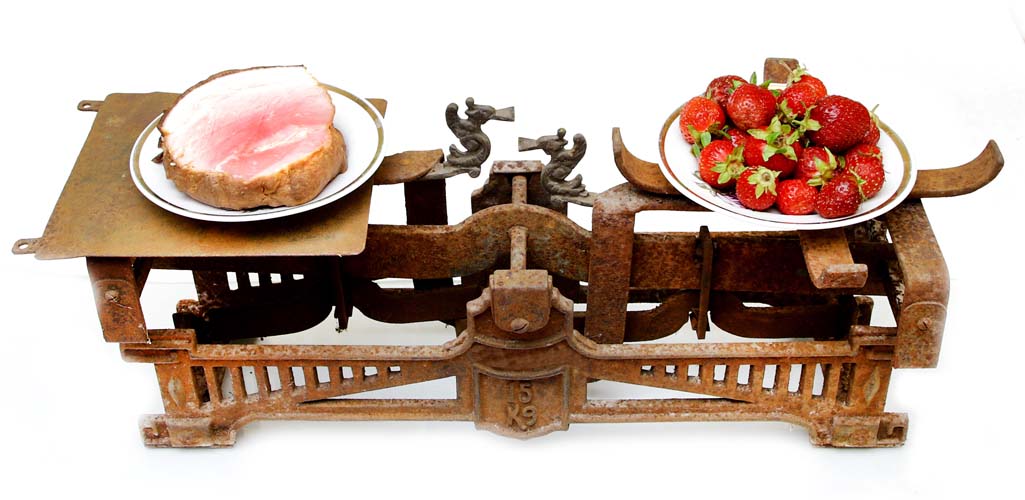
4.4 Low-fat Dog Food
Along that same vein, low-fat dog food is a common need among overweight dogs who suffer from high cholesterol, blood pressure, and/or blood sugar problems.
Fats are a source of energy that is more powerful than proteins or carbs, but they also have the potential to be troublemakers if we allow our dogs to get too attached to fatty foods.
Too much dog food intake is a common cause of obesity in dogs, especially if we use the free-feeding system that allows them to wander in and out and get as much food as they want.
Obesity is also caused in dogs by a lack of exercise. We may feel as though we are too busy to walk our dogs for half an hour a day, but our dogs’ health is at stake here. We can’t afford just to let them sit around and be unhealthy.
To reduce your dog’s weight, you need to make sure that he or she has low-fat dog food that won’t bloat them up.
When combining a low-fat diet with exercise, weight loss will be effective.
Too much fat in a diet can also be caused by table food, which we discussed earlier in this guide.
Too much fat can come if we start feeding our dogs table food and other scraps and treats.
It’s a habit that is easy to get into as owners, especially since we’re so easy to manipulate when it comes to our dogs.
Obesity-caused illnesses are the best reason to say NO to feeding your dog table food.
No one wants to see their dog miserable and lethargic; it’s best to keep him or her on the right track from day one to keep them in tip-top shape.
Low-fat dog food can either be prescribed by a vet, or you can also purchase it from commercial food companies that cater to dogs trying to lose weight and need a more manageable diet.
Ask your vet about low-fat dog food and how to go about structuring your pet’s diet in a low-fat, healthier way.
He or she will probably give you brand name recommendations or an exercise plan. It’s important to contact your veterinarian about the low-fat dog food diet because he or she has experience working with overweight dogs and will understand how severe your pup’s condition is.
Once your dog loses the weight that he or she needs to lose, he or she will be able to go back on a diet that focuses on maintaining that weight and not ballooning back up again.
This diet will need to be adhered to strictly to not jeopardize his or her (and your) hard work.
Also, yo-yo-ing up and down in the weight column is bad for dogs and should be avoided. Once a healthy weight is achieved, stick to it.
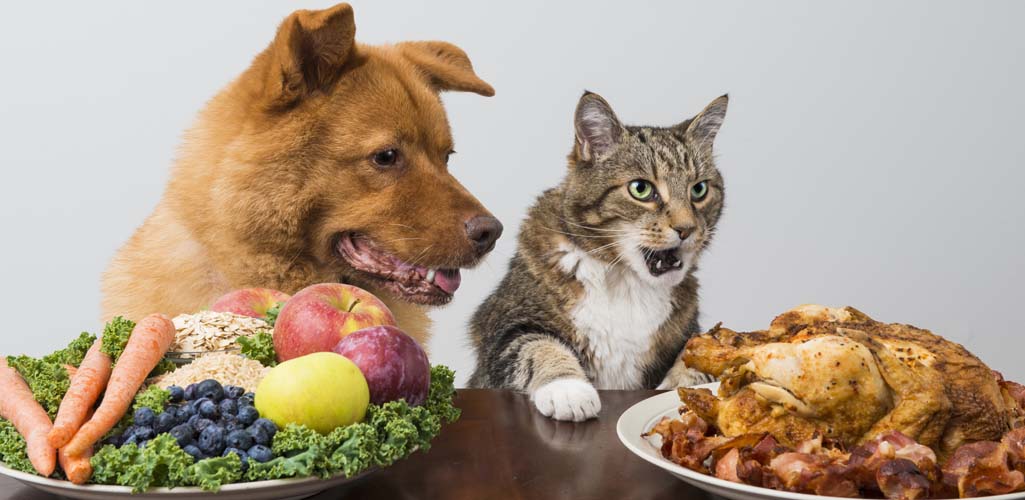
4.5 Low-protein Dog Food
You may have looked at the title of this and gone, “Huh? I thought protein was good for dogs!”
And you’d be right.
It is.
But there are some cases in which protein intake needs to be restricted, and those cases will likely be recommended to you by a veterinarian.
Low-protein dog foods can often only be obtained through a prescription because a general rule of thumb states that dogs aren’t to receive less than 25% protein in their diets.
A dog might have to go on a low-protein diet for serious health reasons relating to the kidneys, heart, or urinary tract.
Low-protein foods are only needed when there are health problems.
Kidney failure, kidney disease, Lyme disease, heart failure, urinary tract issues, kidney stones, and other major ailments are why a low-protein diet may be recommended.
Protein works using all of the parts of your dog’s body, and these parts sometimes are not in good enough shape to handle your dog’s protein needs.
Again, this circumstance is not for you to determine. Because low-protein diets are controversial, your vet will likely need to prescribe food for your dog.
For owners thinking of feeding their dogs low-protein food because they’re concerned about protein's implications for kidney health, there’s no need to be so fearful.
Studies were conducted on the impact of protein on kidney health, and it was found that there weren’t any adverse effects.
Another study was conducted where dogs were split into groups; one group was fed a low-protein diet, one a high-protein diet, and one was a control group that ate the average amount of protein recommended per day.
Again, there were no indications that protein caused mortality rates to increase or adrenal gland failure.
If your dog doesn’t have impaired kidney processing and function, you should be able to feed him or her the recommended amount of protein without a problem.
“Unless your veterinarian has told you your pet has a kidney problem and it is severe enough to adjust the protein intake, you can feed your pet a high protein diet without worrying about ‘damaging’ or ‘stressing’ your pet’s kidneys.” – Drs. Foster and Smith, veterinarians
If your pet has kidney problems, your vet may even decide to try limiting your dog’s phosphorus intact first and making sure that the proteins in his or her diet are high quality and don’t have nitrogen by-products, as that can also infringe on health and kidney quality in your dog.
Bottom line: don’t feed your dog low-protein dog food unless there is a reason for it that is medically related to him or her and your vet has approved the new restrictions on this diet. If you decide to feed him or her a low-protein diet without veterinary advice (just improvisation as a pet owner), that can cause some really big problems for your dog. Always talk to your vet before doing this sort of controversial diet.
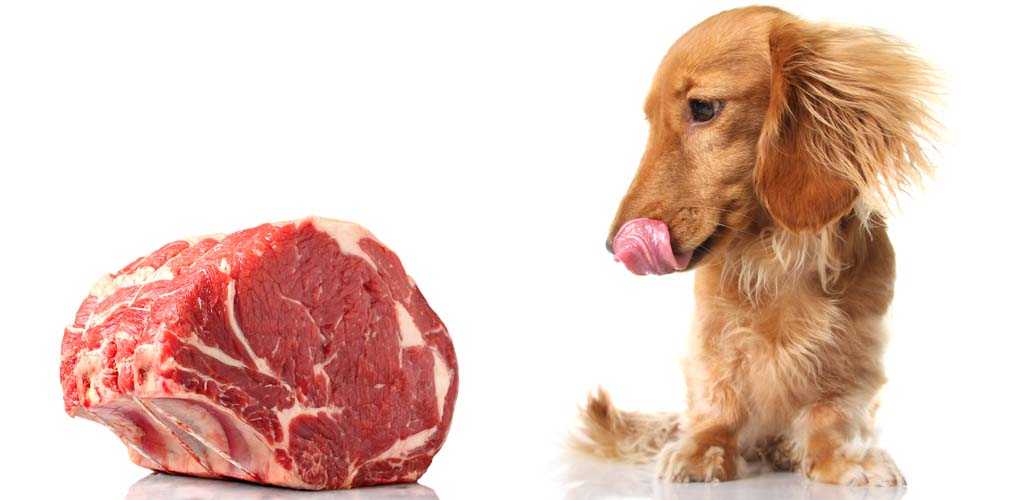
4.6 Grain-free Dog Food
As discussed before, grain-free dog food has been popular amongst owners who prefer that their pets ingest animal proteins only and avoid the main grains such as soy and barley. These dog foods have become more popular and contain ingredients like lentils that were not typical in dog food.
However, in the past two years, the FDA has issued a statement concluding that specific grain-free dog foods are related to a dangerous condition called canine dilated cardiomyopathy.
Having said that, this isn't to say there have been plenty of dogs that have been on grain-free diets and have been fine.
It is just something to be aware of when picking the right diet.
As always, consult with your veterinarian before switching to this specific dog food diet.
Wheat, corn, and rice. These different grains can cause some trouble for your dog’s systems, but they are not toxic.
Grain has protein in it, but the type of protein it contains isn’t digestible in your dog’s tract. Dogs are meat-eaters, and evolutionarily, they haven’t progressed from that to digest cellulose and other plant material into a useful form of protein.
Often, soy, wheat, and corn allergies are among the most common food allergies or food intolerances that dogs experience.
Below, we’ll tell you about each of the main grains: soy, barley, wheat, corn, and rice, and their positive and negative effects on your dog.
Soy
Soy is frequently debated among pet experts because of its quality.
Not everyone is certain as to whether or not it actually helps dogs, but many owners shy away from feeding their dogs food with soy in it just because they are afraid of potential food allergies.
Soy products pass the minimum tests required for food safety, but the minimum standard isn’t what most pet parents want to hear as a sole reassurance for feeding their dog a type of food.
Dogs that are allergic to other non-soy products might be able to source their protein from soy and get nutrients that way. The tiny estrogen levels in the substance are useful for smaller dogs suffering from estrogen depletion.
However, soy is not good for your dog if he or she has hyperthyroidism or any other sensitive thyroid issue, as it has been known to lower thyroid levels and be difficult to digest.
Ask your vet about their opinion of soy and what they think is the best option for your dog.
Barley
Barley is much less controversial, and it has less of a potential for harm. Barley simply doesn’t do anything for dogs, neither positive nor negative.
It has benefits for humans, health-wise, but it’s a neutral substance that provides flavor (barely) and not much else when it comes to dogs.
So, really, the debate comes down to whether or not you want to feed your dog something that is such a neutral, somewhat pointless food.
Wheat
Wheat is often used in dog food because it is so easy to procure and cook. Dogs have evolved in the way that they digest starch, and they can break down carbs more easily—they break down the larger molecules into smaller pieces.
Dogs can eat wheat, and they can digest it, but there is no actual nutritional requirement for the substance in dogs’ diets.
It does provide fiber, which regulates the digestive system and keeps the intestines healthy, which is especially important for older dogs that run the risk of constipation.
Corn
It is not recommended that you give your dog corn. Corn is considered pretty harmless by many pet owners, and while it is not toxic, per se, it’s also not a great thing to be feeding your dog because of the digestive problems corn can cause.
There is even a movement focused on removing corn from dog foods.
In general, giving your dog corn is likely to cause constipation or an allergic reaction, so avoid purchasing products with corn in them.
Rice
Rice is found in many dog foods (lamb and rice, for instance), and in some cases, it can actually be helpful.
White rice can provide relief from stomach upset, especially when served with plain chicken.
White rice calms the gastrointestinal tract and is served in pet foods regularly, meaning that it is safe for your dog to consume.
These grains vary in their recommendable qualities, and for some, it’s just not a good idea. For others, such as wheat and rice, they aren’t bad to have in dog food.
Grains, in general, get a bad name when it comes to dog food, and that’s understandable, especially since they are suspected of causing digestive problems.
Always pay attention to your dog’s health and digestion; if it seems as though he or she is having trouble with constipation, abdominal pain, or other gastric issues, you may need to switch to grain-free dog food.
Speaking of doggy diets, we’ll show you how to implement a doggy diet for your pet in our next chapter.
Dogs aren’t always the most amenable to dieting or having their food consumption restricted, but there’s no reason that you can’t wheedle them into obeying their diet.
It’s all about your finesses as a pet owner and how willing you are to stick to a schedule and its implementation.
In the next chapter, we’ll also discuss homemade dog food.
If you’re interested, we’ll give you a few examples of the ingredients that can go into that creation to provide your pup with the most beneficial nutrition possible.
Chapter Five
Dog Food and Doggy Nutrition
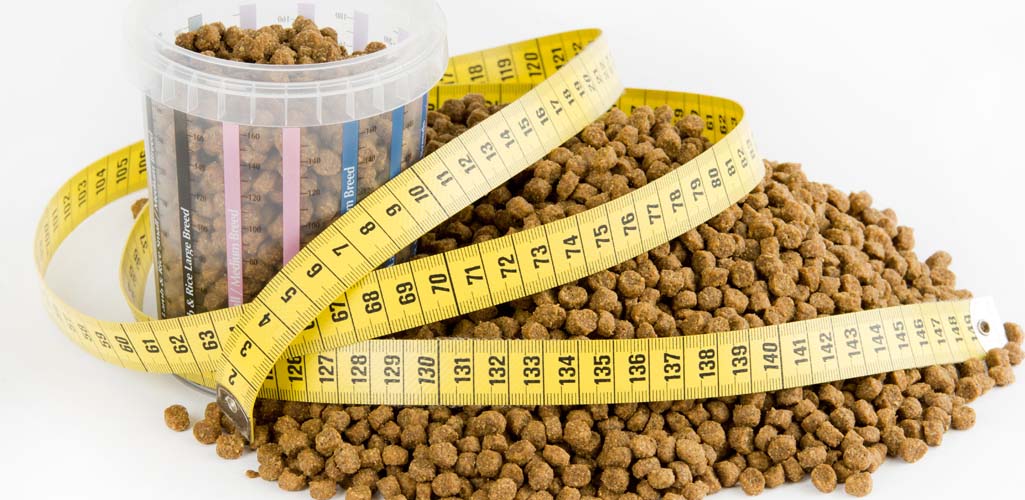
5.1 Dog Diets and How to Implement Them
Once you know that your dog needs to go on a diet, you might find yourself at a loss.
Dog diets aren’t like human ones; they don’t necessarily understand the concept of following a diet and sticking to it.
And while it’s true that dogs might not understand that, that doesn’t mean that we humans don’t.
Let’s say, for example, that your dog needs a weight control diet because he or she is obese.
You would have to make sure that the diet handled his or her health needs while also maintaining the integrity of the diet itself.
Here are some suggestions for tips on maintaining the diet and keeping track of what your pet needs to eat (and not eat).
- Keep a chart. By keeping a chart and writing down either an affirmation that your pet met his or her food goal and/or a list of what your pet ate that day, you will be able to keep track of what he or she eats and make a note of your own competence as an owner.
- Reward yourselves. Give your dog a healthy treat at the end of the week as a reward, even though he or she won’t really know that this is their reward for meeting their diet. You can reward yourself as well for helping your pup stick to his or her health plan, too!
- Stick to a feeding schedule. When dealing with a specific dietary plan or range of dietary needs, you need to make sure that you are observing structure. By observing the structure, you will be able to organize the feedings and keep everything on track. It’s just easier for you to stay on a timed schedule. And what’s easier for you will be easier for your dog.
- Don’t cheat. It can be tempting to cheat on a diet, whether you’re a human or a dog. “Just one treat won’t hurt” is true if it only happens once, but the problem is when that’s repeated over and over, and your dog falls right off the diet wagon and into weight gain. It’s best to not cheat on the diet at all, but if your dog does sneak a snack where he or she shouldn’t, don’t get discouraged and go back to the old behavior; simply start again right after and build up a habit of good dietary behavior.
- When your dog achieves his or her goal weight, don’t go back to the old stuff. When your dog gets skinny again, you don’t want him or her to get right back to the obesity that caused the diet to happen in the first place. Once he or she reaches their weight-loss goal, focus on maintaining their weight at that level. While this might mean a less-rigid diet, it by no means equates to a free diet. Don’t erase all the hard work you did to get to that point.
Along with the same topic of canine diets, one way to incentivize your dog to exercise is through positive reinforcement.
Exercise is a key component of a dog’s life, and without exercise, he or she can suffer physical and psychological problems that will plague their ability to lead healthy lives.
You can use positive reinforcement to incentivize them to exercise and get moving. One example of incentivizing is the use of doggy treats and chews (the healthy kind).
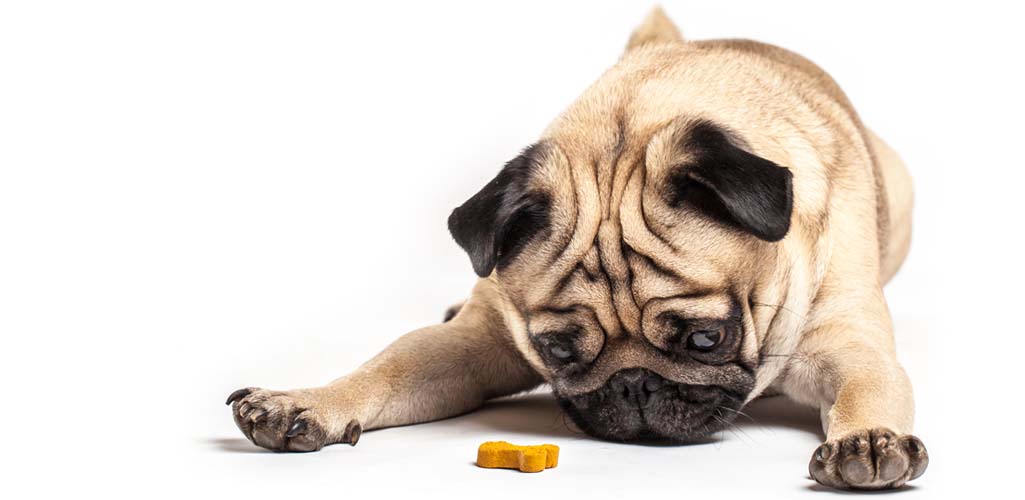
5.2 Dog Treats and Chews
When you hear the word “treat,” you might be tempted to think of it solely in an unhealthy way. But it doesn’t have to be like that.
There are plenty of doggy treats and chews that are healthy for your dog and will keep him or her growing big and strong.
Having a quick treat, you can reach into your pocket for and hand your dog to reinforce good behavior is a great way to do on-the-spot disciplinary training.
Positive reinforcement works better than negative reinforcement, and dogs love food almost as much as they love us, so a little treat here and there is an excellent idea.
There are several different types of treats, some edible and some inedible.
Here are the main ones: bones, dog chews, and chew toys.
Bones
When choosing a treat for your dog, you should consider bones—more specifically, elk antlers.
The bones that we pull from meat from the butcher’s block are dangerous and can break into smaller fragments that shatter and choke our dogs.
They also run the risk of being contaminated with bacteria and other food-borne illnesses often found with meat.
Elk antlers are naturally shed and contain calcium, phosphorus, zinc, magnesium, and other minerals that have leached into the bone. They will keep your pet nice and strong.
Dogs also love the taste of elk antlers, and they are a non-messy way to give your dog a long-lasting, safe treat.
Dog chews
Dog chews are similar to bones in that they are sometimes made of the same material, but dog chews tend to be edible, and, like elk antlers, they are good for your dog’s teeth.
The scraping of the dog chews (which can be flavored or contain meat in) helps reduce the buildup of tartar and plaque that can hurt your dog’s teeth.
Dog dental chews are great-tasting and dentally beneficial; it’s a win-win.
Chew toys
While chew toys are not edible, they also provide a healthy way for your dog to clean their teeth. You can often fill the inside of rubber or nylon chew toys with treats and allow your dog to gnaw his or her way into them. They’ll go wild for that, and it will serve as a healthy and effective reward for good behavior (or just as a playtime treat in general).
Speaking of delicious dog treats, in the next section, we’ll talk about homemade dog food and why so many owners are deciding to take a crack at making their dog’s food themselves (though there’s no pressure if you decide not to).
Homemade dog food can be timely and expensive, but it is something that some owners frequently do and deserves mention in this guide.
We’ll discuss the advantages and disadvantages of homemade dog food, and we’ll even give you a sample recipe as well.
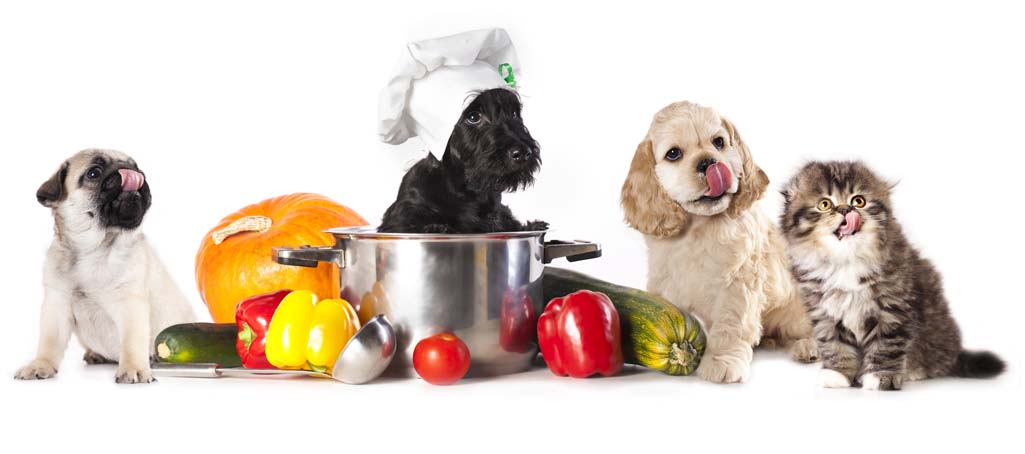
5.3 Homemade Dog Food
Some owners choose to make their dogs’ food themselves. There are several reasons you might want to do that.
Some people don’t trust companies that make dog food, and they feel that they would be better off just seeing what they are making themselves.
Owners spooked by recent dog food recalls may decide that it’s best for them just to purchase and make their dog’s food themselves and eliminate the risk of company-induced food-borne illnesses.
While this is understandable, this approach also has its downsides.
When making homemade dog food, it is more difficult to get the precise nutrition content and ensure that your dog is eating a balanced diet.
This uncertainty and guessing game can prove to be a bad thing for your pet, as an inability to know whether or not you are providing enough of the six nutrient groups (see above) is detrimental.
However, this uncertainty isn’t insurmountable, as you can measure the individual ingredients’ quantities of nutrients, vitamins, minerals, carbs, and fats yourself and then add them all up at the end of the cooking process.
This will require more work, and it will also leave room for error. The AAFCO doesn’t monitor you, so your precise math doesn’t have to be double and triple-checked.
If you want to give homemade dog food a try, you can start with something small, such as making your own dog treats. This will give you an indication of whether or not this is for you.
When making homemade dog food, you still need to adhere to the calorie count recommendation and balanced nutrition recommendation that your dog’s other food has had him or her on.
You can make dog treats that include peanut butter in them. Dogs love peanut butter, and it is an excellent source of protein and fiber.
Make sure that you buy whatever ingredients you include organic and natural.
You can tell if something is organic by whether or not it is USDA-certified. For something to label itself as organic, it has to have a USDA certification.
By purchasing organic ingredients, you will be providing the most beneficial and nutritious experience for your dog and you.
If you like making dog treats and want to try your hand at actual dog food, remember that you need to include animal protein and vitamins and minerals in the food.
Purchase organic meat and produce that has been thoroughly washed.
While making homemade dog food is an understandable reaction to recalls and other company problems that surface in the canine product world from time to time, don’t feel as though you have to make the food yourself because there is no other quality control option.
Plenty of companies are reputable and do a great job ensuring that quality is upheld and met.
These companies also have to meet specific nutritional standards, and that eliminates the guessing game with their nutrient content in a way that someone baking at home cannot.
The ASPCA’s nutrient guidelines recommend that to have a balanced diet, you feed your dog company-made food.
Though, if you do want to try your hand at baking, there are many recipes out there for you to try.
Monitor your dog’s health closely; if he or she seems to be reacting poorly to the food, take him or her to the vet and change the diet to something canned or packaged.
Also, remember that even if you are feeding your dog human-grade ingredients, this does not mean that the risk of unsanitary bacteria in meat and produce is eliminated.
Still, practice proper safety precautions to avoid food poisoning and other illnesses.
Chapter Six
Dog Food FAQs
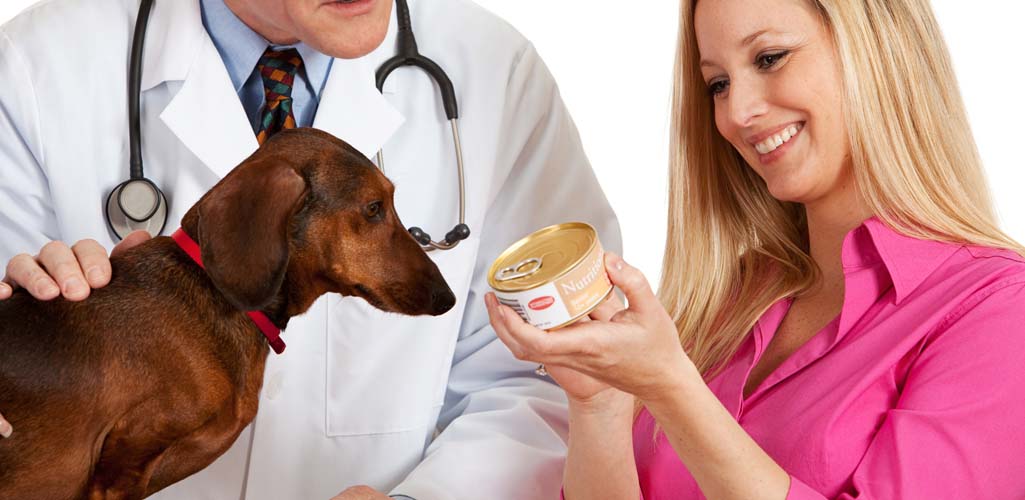
You’ve made it to the end of the guide!
We hope you have learned a lot and feel confident about your next trip to the store to shop for dog food.
This section will answer the top five frequently asked questions about dog food that owners encounter when shopping for dog food.
Consider this a recapitulation of what you’ve already learned (almost like a little cheat sheet!).
FAQ #1: What ingredients should I make sure are in the dog food I buy?
Ensure that your dog food contains an animal source of protein, such as bison, turkey, chicken, beef, or any other protein source that will provide the necessary nutrients.
If your dog has a meat intolerance or allergy, you can try plant protein sources, but those are unlikely to be as fulfilling, and you may need to see your vet about supplements.
Also, make sure that your dog's food contains vitamins A, B, and E and minerals like zinc, calcium, phosphorus, and magnesium.
A healthy fat count is important, but you don’t want the food to be too fatty; otherwise, you risk weight gain.
FAQ #2: What ingredients should I make sure are NOT in the dog food?
Stay away from the fake additives, preservatives, dyes, and flavorings.
If your label reads ethoxyquin, glycerol monostearate, or propylene glycol, put it away, as those additives can potentially cause harm.
Dyes such as Yellow 6, Blue 1, and Red 40 are also no-nos, as yellow dyes have been found to cause illnesses in animal tests.
FAQ #3: Should I avoid meat by-products?
It depends on your personal opinion of the meat by-products. Meat by-products are considered the inedible parts of the animal slaughtered.
Though it is not inherently harmful (if it were, the AAFCO wouldn’t let them sell it), it isn’t as nutritious and tends to be an indicator of lower-quality food because it was made with butcher scraps.
FAQ #4: What about grains?
You’re going to want to avoid products with corn in them, especially, but wheat and rice aren’t bad for dogs.
Soy is tricky, as many dogs find themselves unable to tolerate soy in their digestive systems.
Evolutionarily, dogs aren’t set up to digest sources of proteins that are non-animal, so keep the grains to a minimum or, if you believe that your dog’s intestinal tract is sensitive already, stick to grain-free, or if there are grains, keep them to white rice.
FAQ #5: What do I do in the case of a recall?
A recall takes the products off the shelves at the FDA’s request, the company’s request, or a statutory order on behalf of the FDA.
If you find out that your dog’s food has been recalled, dispose of it immediately and wash all the surfaces in your home that the infected food may have come in contact with.
Call your vet and inform him or her of the situation so that they know your dog could be in danger.
Monitor your pet’s health very closely over the next week to see if there are changes in his or her behavior.


